






A: “[My biggest responsibility is] taking care of my grandpa. We had to move over the sum mer to his house [in Redondo Beach], and I worry about him all the time and I want to take care of him. He recently had a stroke while [my family] was in Sacramento visiting our cousins,
A: “[My biggest responsibility] is defnitely theater. I have theater for about 12 hours a week. I'm in theater more than I'm in classes at school, and I have to memorize dances and lines outside of rehearsals.”
Q: What encouraged you to take up this responsibility?
A: “It's really fun and it just gives me some thing to do. It's a great way for me to be able to be active while also singing and acting, which I love to do. I also people and I love the nity [in theater].”
-Niko Guerra, 12
A: “[My job] is a pretty big responsibility be cause I have a commitment where I work once a week and if I don't go, I'll get fred. I work at El Gringo, a Mexican restaurant in El Segundo.”
Q: What encouraged you to take up this re sponsibility?
A: “I really wanted to make money. I also really like working because feel independent. It's freeing to not have to my parents for every
-Avery Snyder, 11
A: “Balancing school [during the week] with art school and working [at Gum Tree] on the weekends. It’s a lot sometimes, juggling all those things and then also getting to school on time and completing all of my homework.”
-Natalie Jones, 10
Q: What are the biggest responsibilities you see among students?
A: “Responsibility or challenges I see among students this year, coming out of the pandemic, are mental health issues from students that have a lot of anxiety. This school year and last year I've dealt with a lot of students that are sufering from anxiety, and that's sad. Or, [many students] are having a hard time getting their work done, or they have social anxiety from things at home and problems with their parents or their siblings. I think anxiety can lead kids down a bad road because it causes them to procrastinate on their work. It causes students to get paranoid or feel lonely and set apart.”
-Amber Keller, APUSH and AVID teacher

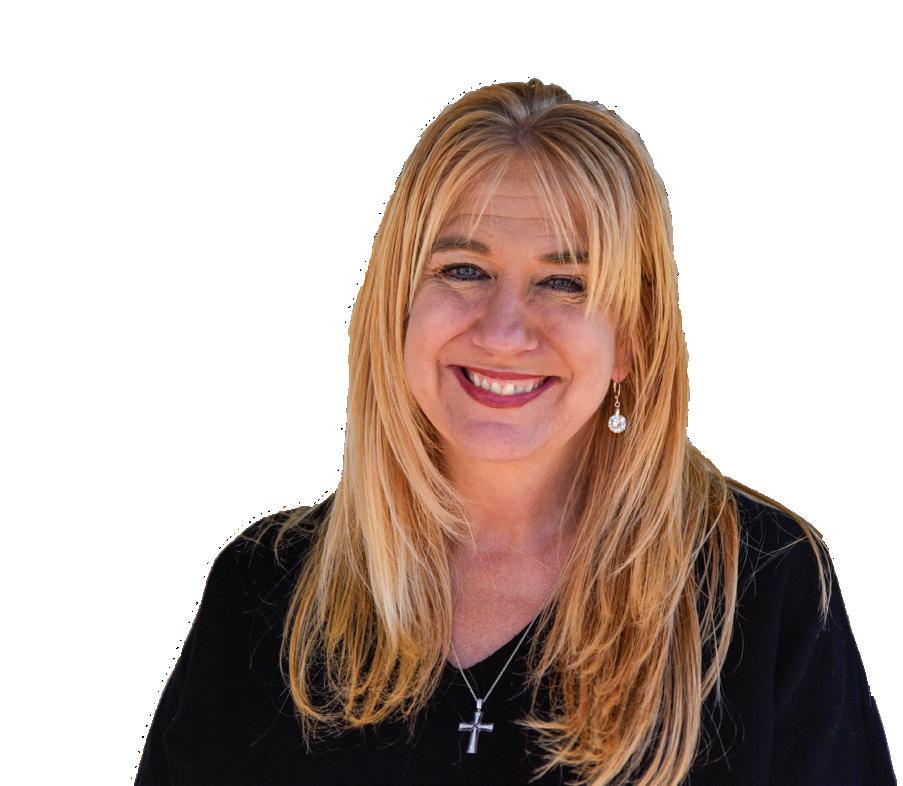
editors-in-chief
Katarina (Haven) Beches Ruby Crosthwait Elise Haulund online manager Zelia Lerch news editors Erika Glass Sara Miyake-Singer features editors Mia Dowdell Emilie Takahashi Marley Van Pelt opinion editors Scarlett Mische Romi Riss entertainment editors Allie D'Amato Sydney Lamich sports editors Ethan Chi Ty Soria copy editors Marin Cantrell Cristina Couch Stavyah Naveen Zoe Rossi Mia Schrift writing editors Lauren Greene Ethan Lerner Simra Zargar online editors
Cristina Couch Lucy Davis Rena Felde Lauren Greene Ria Lopresto Stavyah Naveen Troy Nevil Kat Otey advisor
Kerri Eastham
staf writers Ariya Anvari Ava Anzivino Luca Artiga Hadeel Azzam Danielle Bellamy Calvin Bonn London Carbone Nicholas Car rozza Lauren Choy NyAire Davis Charlene Elam Izzie Escobar Yasmeen Ford Daniella Gross Scarlett Kindt
Isabella Kohler CaraMia Leal Valentina Masoni Andrew McKenna Summer Puter baugh Amina Raïss Priya Ramcharan Avery Rapoport Aaliyah Roberson Victor Simoes Sadie Simmons Aidan Tseng Claudia Turner Sofa Villanueva Malina Young

Anthony Biedenbender Marin Cantrell Olivia Flanders Jazmine Jimenez Pete Paguyo Sascha Perdue
advertising, circulation, & distribution manager Nicolas Tomsio illustrators

Esperanza Carolipio Allie D’Amato Lola Diehl Kaitlyn Hodac Bella Langa Scarlett Mische Samarah Nuques
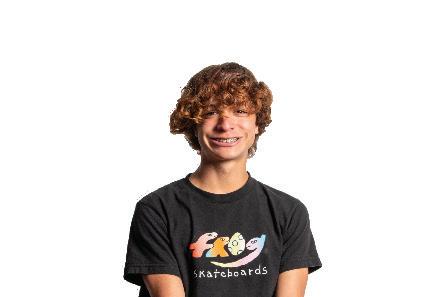
After only six weeks of prepara tion, the RUHS Theatre Arts de partment premiered its rendition of the Broadway musical “Chicago.” Run ning from Oct. 6 to Oct. 9, this was the frst time in the school’s history that the theatre department started the year with a main stage musical.
Utilizing a smaller cast of only 25 peo ple, RUHS Theatre Arts Director Melissa Staab explained that her vision for the mu sical was something more "intimate" than for other productions. This is why she spe cifcally looked for performers who knew how to "get a reaction" from the crowd.
“The energy from the audience [during
by Claudia Turnerthe performances] fueled everyone,” Sta ab said. “If the cast’s performance during rehearsal was at a level seven, [during the opening night] everybody bumped it up to a level 10. Everyone just was so energized and engaged.”


According to Staab, this teen version navigated the musical's themes of murder, adultery and corruption in a family-friend ly manner. The theatre department, Staab says, is known for “creating a safe space at rehearsal” and having an “open” environ ment, which they achieve by prioritizing the comfort levels of the cast and crew.
“We had many conversations with the cast about the maturity of the content. We


always talked about consent at rehearsal, that if [an actor] ever didn't feel comfort able with anything, they could just let us know,” Staab said.
For senior Eva Lopez-Quintana, who played the co-lead role of Roxie Hart, what sets “Chicago” apart from other shows RUHS has done in the past is its unique “vaudevillian” dance style.
“Classic musical theater has big, bright, wacky energy, but [the choreography for “Chicago”] is very sleek and sophisticated, very tight,” Lopez-Quintana said. “I wasn't used to being constricted as a dancer, so that was defnitely a hurdle I had to jump over.”
“Chicago” also recruited the RUHS Jazz Band, having the members learn the musi cal’s score instead of the music they would normally perform at concerts or competi tions. According to Staab, although stu dent volunteers have always performed the music for shows, this collaboration marks the frst time that a class like Jazz Band has worked with the Theatre Arts program.
“Our programs are kind of used to working with each other, so it wasn't too hard [to set up the collaboration],” Staab said. “Even though it's band and drama, all of us are performing arts. We're just kind of one big family.”
Led by frst-time conductor, longtime Jazz Band member and senior Joseph Mintz, the band carried the score from the opening curtain until the fnal bow. Mintz noted that the only major change when performing with actors was that the band had to be “really into the music."
“There are a lot of big, main character moments during the show. I'm really proud of the band for pulling it together and be ing able to play the musical cues through all of those moments,” said Mintz. “Being with the dancers and the actors made [the experience] more fun.”
Since the production had a six-week time constraint, many cast and crew mem bers had to give up free time before and af ter school to refne their roles in the show. Senior Aurora Dietz, who played her frst
co-lead role as the part of Velma Kelly, took the time to work through her “actor’s block” (the term for when an actor is struggling to fgure out how to best embody their char acter) after class, staying up late to watch videos of past performances to receive in spiration from women who had enacted the role before her.
“I studied the show. I studied the his tory of the characters because it was based on real events,” Dietz said. “I tried to learn about each of the diferent people who played the role and what they took away from it.”
If the countless standing ovations the cast received were any indication, the au dience seemed just as captivated with the characters of “Chicago” as the actors were. One such crowd-pleaser was Amos Hart, played by junior Diego DiPasquo, who, despite having limited time on stage, still managed to tug out quite a few sighs of pity from the audience.
“I couldn't believe how much I connect ed with the crowd,” DiPasquo said. “It was so much fun to see their reactions. I think my best quality as a performer is simply be ing able to connect with the audience and have them feel emotion. And I defnitely used that in my role, because [the audi ence] felt really bad for Amos.”
As for Dietz, she says the moment she felt proudest of was Roxie and Velma’s fnal number, which fnished the show of with the duet "Hot Honey Rag," which used the original choreography from the Broadway musical.






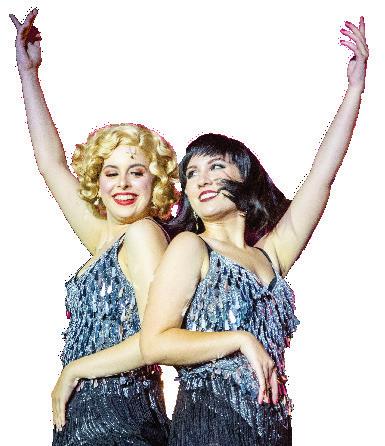
"We worked so hard on [the number], and I'm very proud of both of us and how far we've come with everything in the whole production," Dietz said. "Eva [Lopez-Quin tana], I love her. She's so good, and doing that number with her was incredible."
Lopez-Quintana felt similarly about their last act.
"The fnal sequence was crazy because Aurora and I have been in the department since our freshman year, and being togeth er for this moment in our senior year meant a lot," Lopez-Quintana said.
When students walk into the school library, they are no longer met with outdated books and beige chairs, but rather sleek new bar tables, sofas, shelves on wheels and media tables. Through a grant from the Redondo Beach Education Foundation (RBEF), librarian Cassandra Jones has re arranged the school library with new furni ture, making the library a “relevant space” for students.

“We have new cafe tables for a Starbucks vibe and a library lounge,” Jones said. “We are making it relaxed, [for] if [students] need to just take a load of or catch up with a friend.”
Jones envisions the library as a modern and accessible resource for students. This is something that is “vastly diferent” from the library’s previous setup.
“I have had this vision since I became a librarian in the fall of 2019. The mixed seating and modern furniture make the library more useful for students,” Jones said. “We used to have nine bookshelves that were close together and full of books that nobody had touched since the 1980s.”
Noticing the outdated library setup af ter assuming this position, Jones knew she eventually wanted to modernize it.
“It took me a while to fgure out what we really needed in the library, so my so lidifed ideas came after much observation, pre and post-pandemic,” Jones said. “I’ve also spent a considerable amount of time


visiting other high school libraries for in spiration, such as El Segundo High, Chad wick School, and another private school called Flintridge Sacred Heart, which has the most beautiful library I’ve ever seen.”
According to Jones, she talked to Dr. Susan Wildes, RBUSD’s Assistant Superin tendent, and was able to secure the money from RBEF for all the library renovations.
Jones hopes to have these renovations wrap up by January 2023 due to holiday backup and supply chain issues.
Using the new furniture, Jones is also able to implement new book organization techniques called genrefying, where the books are separated by genre to be more convenient, according to Jones.
“When you go into Barnes and Noble, you see sections like mystery and fction. We are working on genrefying our book collection by putting genre stickers on all the books and then sorting them on porta ble shelves. The goal is to make the book shelves more approachable for kids,” Jones said.
Sophomore Kayla Halpin, who has been going to the library since freshman year, saw the furniture being delivered and feels that the blue color schemes of the pat terned sofas help to make the space more “comfortable.”
“It doesn't feel boring and dull any more,” Halpin said. “In the morning, I go to the library because it’s warm and the at mosphere is nice with all the other people.
I appreciate the library choosing to make some changes because it makes it feel more welcoming.”
Aside from the furniture, Jones is also planning behind-the-scenes upgrades. The subscription to the database EBSCO (Elton B. Stephens Company) is being renewed for the year, which will be available to stu dents through the library’s website. EBSCO is a search engine where students can look up history, science and other academic ref erences for school projects. Joni Cantrell, who helps students in the library with Chromebooks and printing, explains how EBSCO will expand the library’s selection.
“Say they come in and look for a book on mental illness, but we only have two or something, or just not enough,” Cantrell said. “The database expands the informa tion we have available for students.”
Cantrell explains how she sees students benefting from the library changes as a whole.
“Several arrangements are not com pletely done yet, but we wanted to just make the space more modern and visible for high schoolers. The furniture came in a couple of weeks ago and is still coming. It's been really fun to see more kids come in and use the library as a hangout place.”































































































Homecoming was held on Oct. 15, and its "Hollywood" theme led to some snazzy outfts
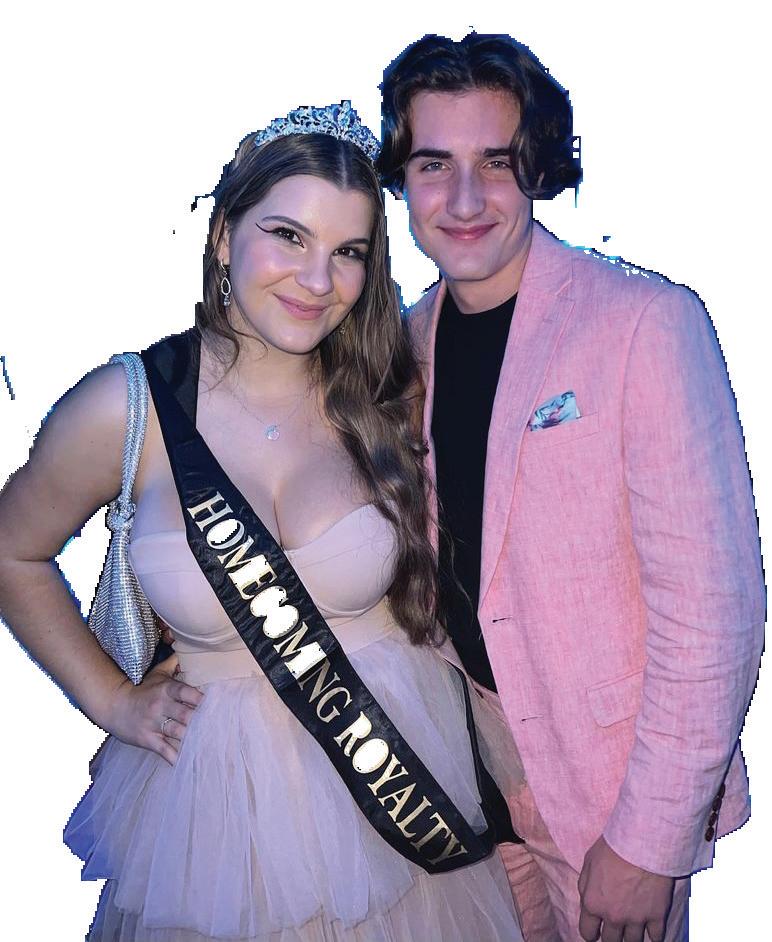
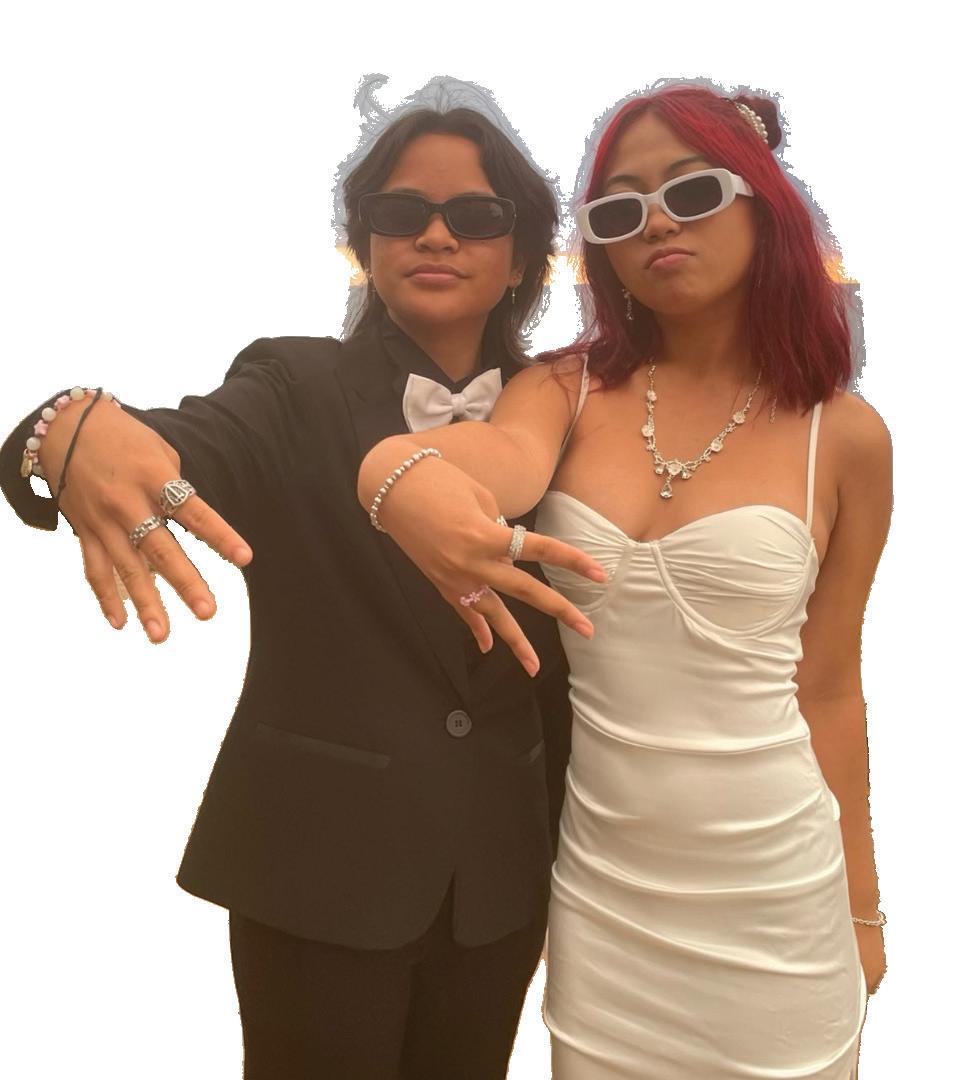 by Jasmine Puka
by Jasmine Puka
Q: Would you say your dress was an accurate refection of your personality?





A: I think [the dress] was a very accurate representation of my personality because I don’t like basic stuf so I always need something sparkly, something that stands out. I feel like the dress matches my personality because I like to stand out and I am very outgoing.
Jordan Grissett, seniorA: I don’t know how to describe it because we kind of just sent it in like "What if we win?" and we didn’t think we were actually going to win the contest. So when we won I was like, "Yay!" It was a fun outft because our friends were joking around about how we look like "Men in Black" be cause of the black suit and sunglasses.
- Yssa Bumagat, juniorQ: What inspired you to wear this outft? What com ments did you get due to it?


A: I wore it because it reminded me of Princess Diana. I thought my outft was really extra. Someone said I re minded them of Queen Elizabeth II. People seemed to really like it. Surprisingly, everyone was like, "Oh my God! I love your little pearl thing. It’s so cute!"
- Gianna Mariani, sophomore
Q: Why did you wear that suit?
A: I thought the suit looked cool and Alyssa (his girlfriend) loves pink so we thought we'd coordinate. We wanted to stand out like people would on the red carpet.
-Jake Lambuth, senior
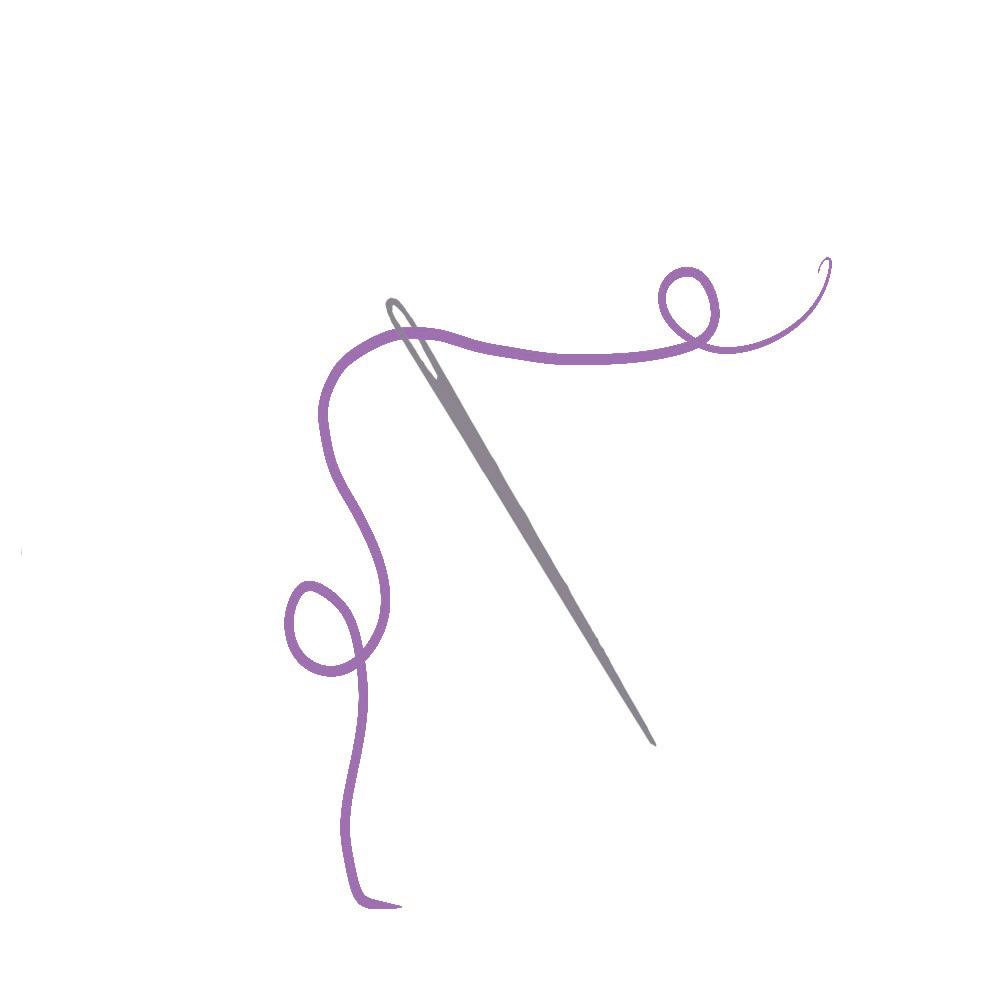
After drafting designs for new out fts, junior Case Fulton proceeds through their school day before heading to the theater after school. Here, they put the pedal to the metal and the needle to the fabric as they execute their vision, bringing their costumes to life for upcoming productions.

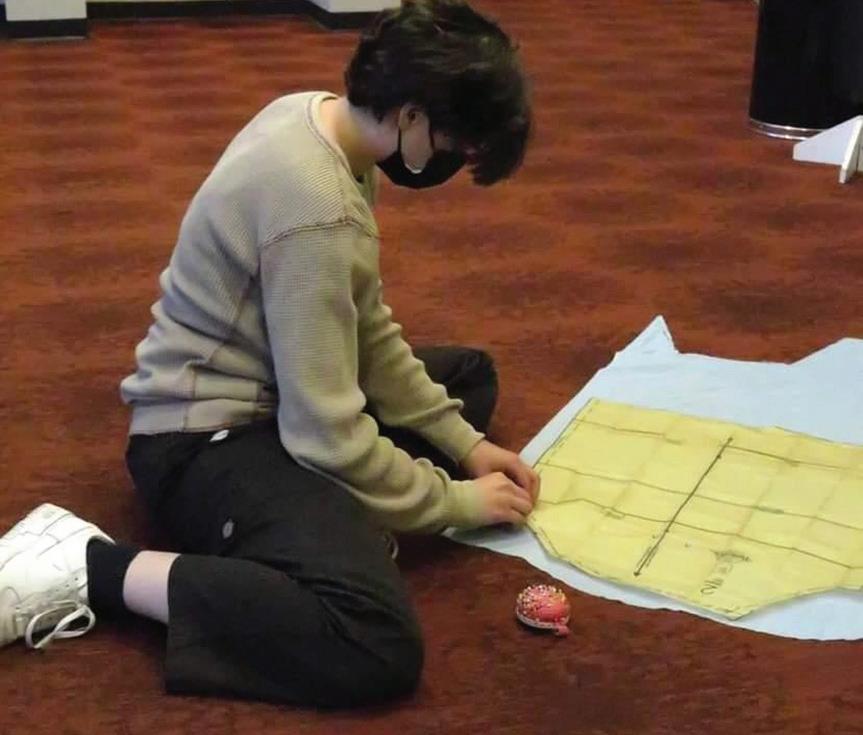
Fulton started fashion designing during COVID, when extra time allowed them to binge “Project Runway,” which inspired them to try designing similar outfts.
“I started teaching myself how to sew and it all kicked of from there,” Fulton said. “Before high school, I never thought of myself as fashionable [or] a designer.”
This newly discovered passion prompt ed them to join the theater program for the online production of the Addams Family in their freshman year. More interested in costume designing than performing on stage, Fulton found a place on the cos tume crew and stuck with it for subsequent shows.
“I felt lost in the beginning of my fresh man year online,” Fulton said. “I’m so lucky to have just found an accepting place on campus and I feel like I’m a part of a lit tle family.”
Fulton served as Costume Designer for the recent production of “Chicago,” leading the costume crew without the typical assis tance of an outside professional.
“Every show is diferent because you're not just designing costumes, you're leading the crew of other students and teaching them how to sew and design,” Fulton said. “I'm going to be costume designer for ‘She Kills Monsters,’ which is our next show. It's diferent because there's cosplay aspects to it.”
Chicago’s Stage Manager, senior Lilly
Kruk, has known Fulton since last year and praised their contributions to the recent shows, especially after “Elf the Musical.”
“They have such a talent for sewing and costuming,” Kruk said. “I don’t think any of [the productions] would be possible with out Case sewing those costumes every day.
Case is one of the rocks in the department,
It's helped me fnd something that I'm pas sionate about and lets me commit to a hobby that can evolve and change. It's allowed me to learn how to make mistakes and move on from them."
CASE FULTON JUNIORespecially for costumes.”
According to Kruk, Fulton is always reli able and willing to take on new responsibil ities, becoming more of a leader within the department throughout the years.
“They put a lot of love and hard work into all the shows,” Kruk said. “Compared to last year, Case is a lot more authorita tive. They are someone that keeps the ship running.”
Outside of the school’s theater depart
ment, Fulton indulges their designing pas sion by co-running the Fashion Institute of Designing and Merchandising (FIDM) Fashion Club on campus with Kruk and others. As part of this club, Fulton partic ipates in fashion competitions to compete for scholarships to attend the prestigious art institute of the same name after high school.
“It's a good opportunity for people on campus who want to go into art and who want to go to an art school because you can get a lot of money for just submitting your designs that you already have,” Fulton said.
Through these activities with Fulton, Kruk has experienced Fulton’s fashion design ability, enjoying the creative and personal aspects of it. Kruk sees fashion in general as a form of self expression.
“Fashion is [an activity] where you get to show a part of yourself to the world,” Kruk said.
Fulton takes this message to heart, and by centering their life around fashion design, they use it as a means to express themselves, making it a crucial part of their identity.
“Being non-binary, every day I feel dif ferent about how I want to look and how I want to present myself, and so I connect what I wear to my gender identity,” Fulton said. “It depends on the day, but I can em brace a part of myself through fashion.”
As Fulton’s identity has evolved, so has their design process. Initially, Fulton only designed outfts for themself, but have branched out into designing for others, broadening their abilities and styles.
“It’s helped me fnd something that I’m passionate about and lets me commit to a hobby that can evolve and change,” Fulton said. “It's allowed me to learn how to make
mistakes and move on from them.”
Looking ahead, Fulton plans to go into fashion as a career. The fashion business is multifaceted, so Fulton is considering both the marketing or editorial side of fashion as well as the actual technical designing of patterns for the outfts themselves. What ever comes next, Fulton is glad that fashion has allowed them to rise above “being an insecure teenager.”
“Finding a way to express myself al lowed me to not care about what other people think,” Fulton said. “It’s allowed me to be myself and not in the respect of just expressing my gender, but in the respect of ‘This is who I am, take it or leave it.’”
Not everyone has a choice: school events are open for everyone, but that doesn’t mean all can attend. For students with disabilities, mental or physical, the option to go to school events might be limited. Their choices can expand when students ofer assistance.

The Event Mentorship Program (EMP), founded this year, gives disabled students more opportunities to experience high school events to the fullest.
Senior Winston Watkins, a mentor in the EMP program, gives those participants more accessibility to diferent events.
“[The program] allows them to experi ence events like homecoming or football, which they might not normally be able to do,” Watkins said.
After his training, Watkins joined in on new experiences as he assists those in the program.
“At football games, I've only thought of myself being in the middle of the fock, yell ing and screaming with my friends,” Wat kins said. “[This role as a mentor] gives me a diferent perspective, and I never thought I would be doing something like this.”
Both Watkins and the students he men tors beneft from the experiences obtained through EMP.
“At the surface, I'm only helping them by getting them out of these [routines], but I'm also learning, as well as the other men tors. We're learning how to interact with the special ed kids. It's totally diferent,” Watkins said.“The [mentees] aren’t difer ent. They're people, and that's something you have to understand.”
The “unique and diferent” aspect of his role helps him to recognize the importance of the program, as not many people have
had the opportunity to work with special ized students, according to Watkins.
“[Mentoring] has never been something that I've sought out, but it's been in the back of my head of something that I could always do. It's just an intrinsic thing for me,” said Watkins. “It’s something that I do that has [become] rewarding.”
Assistant Principal Jefrey Rosadini oversees EMP as students volunteer their time to mentor special day students and work to contribute to the growth of the program.
“The larger goal we are always striving for here at RUHS is to build on our inclusiv ity for all students,” Rosadini said. “Some of our students have special needs, and do get a lot of support within the classroom. But with this [program], it allows them to experience some of the other aspects of high school, the social aspects, without having an adult right there with them.”
The group thus far has helped four stu dents attend the two football games they’ve done thus far, but plan to attend theater productions and dances.
“We’re looking at a couple basketball games and a couple dances down the road. We’re also looking at possibly attending a play, maybe something with ‘Les Mis,’” Ro sadini said. “We want to give [the students] a variety of opportunities to experience RUHS outside of the classroom.”
The program features the collaboration of mentors and mentees working together. The mentors are trained on how to handle the needs of the students that they mentor as well as how to fulfll the expectations of the program, according to Rosadini.
“Most of the kids that have signed up al ready are great and understand a lot of ev eryone's situation, as they are all diferent,”
Rosadini said. “The training was a chance for them to ask those questions and, after each event, we try to have a debrief with the mentors and discuss what worked well, what didn't work well, and what we can change for the next one.”
Rosadini hopes that in future years more people can be a part of this program and the learning opportunities it presents.
“I hope that, in the long run, the kids [who will be] our mentors, will have an understanding about students with needs and understand their commonalities and diferences,” Rosadini said. “[I hope] that they will focus themselves going forward on how they view people, overall, and it will expand their horizons.”
Leading the Essential Skills class at RUHS, Dr. Monica Mallet also speaks to the importances of these pro grams to the development of high school students, as “some stu dents don’t have the language to communicate [their] expe riences.”
“We have to get our students out of the routine of being alone so, socially, we want to get them involved in other activities and doing new diferent things,” said Mallet.
“You just want to think about an aid as an extension to help that person be success ful. At the [football] games, there's a lot of noise that can be overwhelming. You want that person to be successful and enjoy themselves.”
According to Mallet, acknowledging the confdence and encouragement mentors bring as they are “a familiar face” so that “a student can enjoy some of the things that typical students do.”
“Some of the benefts are engagement, socializing and emotional connections. They're learning how to go out and have fun and socialize with their peers and to be a part of the community,” Mallet said. “There's a lot of in clusion and it helps their self esteem and their social and emo tional well-being. It helps all around ac ademically because, if you're happier, it’ll beneft you.”
This relationship between mentor and mentee is not one way, but rather both can build of of one another.
“It helps build empathy because it makes you want to look at how the other person may be experiencing life, amd take the focus of of yourself,” Mallet said. “Empathy is a skill that people need, in leadership roles or any role in life. We all need a bit more empathy.”
What could be more quintessen tially 2000’s than a robot dog designed for iPods?

Junior Giancarlo Lombardo has been collecting iDogs since 2008. The robots are capable of playing music, dancing along to tunes and reacting to the melodies they hear.
Today, Lombardo’s collection includes 85 iDogs. He catalogs iDogs, Gemmy elec tronics (including the Big Mouth Billy Bass®) and other items on his YouTube channel iDogFan41.
What developed Lombardo's interest in collection was the resistor inside his sec ond iDog, which gave it a diferent pitch. The iDog develops its own personality as more music is played for it, thus making every iDog unique.
“Normally with a toy, you pick it up and use it, and it does the same exact thing for a good fve to ten minutes. But with the iDog, it does so much, and it has these moods that are built in. If you neglect it, and you don't play it music and you don't give it at tention, it'll go down in mood,” Lombardo said.
According to Lombardo, the iDog was originally developed by Sega Toys, and distributed in the United States by Has bro. It features a honeycomb LED array on its face, and touch sensitive buttons on its
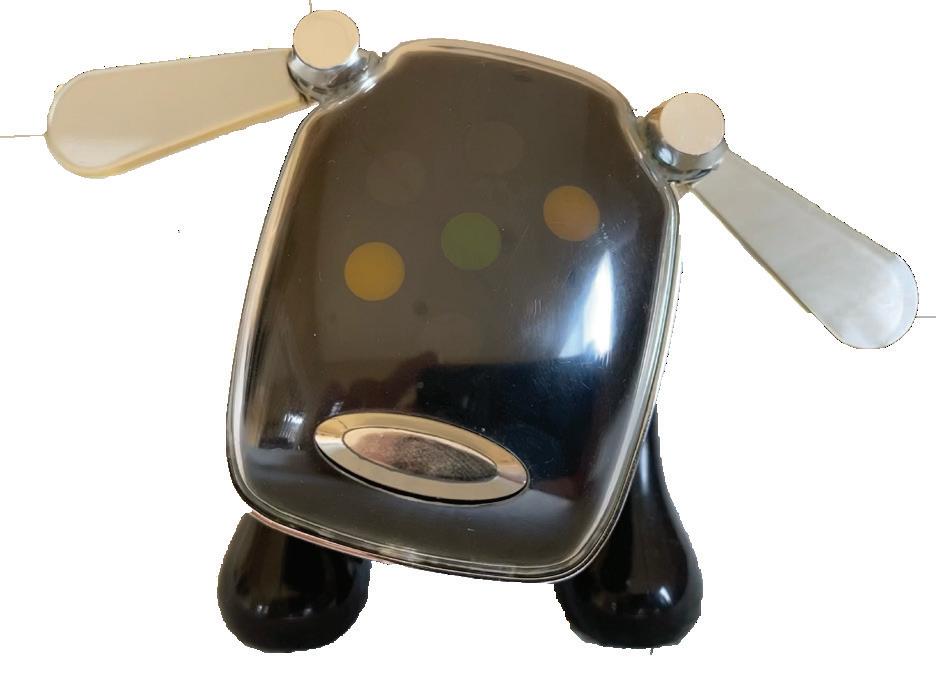
tail and nose. Although designed to match the iPod, the iDog is compatible with any 3.5mm audio jack source.
“They just were the coolest thing to me because of the way the lights on the face [were], the way they had diferent songs and the way they moved. It really fascinat ed me back then,” Lombardo said.
In the 2000’s, globalization, technolog ical advancements and consumerist trends had combined to form a new wave of intel ligent gadgets and toys that included iDogs.
The iDog closely matches the plastic and stainless steel aesthetic of the original iPod. According to MoMA, “The iPod, a now–ubiquitous cultural artifact, is Apple's most celebrated industrial design product," and soon became the forefront of industrial de sign for consumer electronics.
The plethora of advanced devices avail able during childhood inspired a familiar ity and curiosity for technology and com puters, according to Lombardo. What was only a toy during childhood could lead to a lifelong skill or career.
“I think some of it was just that natural childhood wonder and curiosity for how it all went together: the lights on the face, the movements, all the diferent sequences and light patterns that it had back then, really sparked an early interest in that type of op eration,” Lombardo said.
his iDogs come in a variety of conditions, learned a variety of skills in order to main tain them. Original sealed iDogs often fail when electric current runs through their components for the frst time after count less years. To solve this, Lombardo has learned skills such as soldering, and en gaged in lots of practice.
“When I was little, I always thought that [repairs] were impossible,” Lombardo said. “A lot of it was just trial and error, [and] I did it on my own. I had some dogs that I was using for parts that I didn't care about that much that were in basically unfxable condition, so I kind of experimented with those frst learning how they all worked.”
He also made tutorials on YouTube for others who need help.
“There aren’t really any iDog tutorials, since it was just me seeing what was wrong and going from there. I decided to make a few tutorials myself on YouTube, and I'm hoping to do that again soon so other peo ple can know what they're doing,” Lombar do said.
Although he doesn’t have a specifc goal, Lombardo believes his “best case scenario” would be developing robots and anima
tronics. He admires most the work of Michael Curry Design, an animatronics, puppetry and set-design company, re sponsible for much of the technology at Universal Studios and the Lake of Dreams show in Las Vegas.
“I'm hoping to expand this into a feld that's more mechanical, or maybe electrical engineering in the future, which are tough felds to get into right now. But I feel like with this early experience, it's giving me a head start,” Lombardo said.
His friends seem to agree this could be the right path for him.
“I think he comes of as more of a STEM person, but I feel like he’s pretty creative and artsy [too],” junior Azalea Gleason said. “All of his hobbies include creativity. He's just really good at all that stuf.”
Today, he is more modest with his ex pectations.
“I’m getting to a point where they're just not as practical. They were meant to be toys after all. So, maybe one day I’ll part with some of them,” Lombardo said.
Regardless, Lombardo takes pride in the source of his appreciation for robotics and engineering.
“If I were little I would have never known that this toy dog would practically build my future and make me so passionate about engineering and how things work,”
or some, playing an instrument in ffth grade is seen as a chore, but for others, it is a experience that can lead to a life long passion. When junior Nadia Hoang chose to play violin in her school’s orchestra instead of joining band,
Hoang is now a part of the El Camino Community College orchestra, where she can practice and improve at the violin. She has worked hard at the violin from a young age, so she found it relatively “easy” to get into the orchestra this fall. So far it has been an “amazing and beautiful” experi
“Being in the orchestra helps me connect in a spe cial way to others who also enjoy music,” Ho ang said. “It’s super fun to play with them.”
However, there were some minor dif ferences compared to her old orchestra that Hoang had to adjust to.
“I realized that my old conductor babied us in a way, but we were all learning how to be in an orchestra, so it makes sense. I wasn’t used to relying on our frst chair so much or having the conductor not be as expressive,” Hoang
She quickly ad justed to the com munity aside from these slight strug
gles. Something that made her more com fortable is that the members are split into a group that is still in school and a group that has already graduated college. Since she is in high school, she is in the younger group, allowing her to be around people closer to her age.
“I didn’t realize how big the age gap was going to be. The orchestra is more of a community thing than just the college,” Hoang said. “[The members] are still re ally welcoming and nice even though I am younger.”
“ NADIA HOANG JUNIORHoang’s orchestra director, Dr. Joanna Medawar Nachef, has only positive things to say about her. She strongly appreciates Hoang’s commitment to and during the three hour rehearsals on Tuesdays and how excited she is to learn about practice.
“She is very serious about her role as a violinist and is always eager to learn what the homework is so she can practice at home. She is punctual and gives her all at every rehearsal,” Nachef said.

Hoang discovered her love for the violin at her school orchestra in Illinois. She con tinued performing with that orchestra un til she moved to Redondo Beach two years ago. When she discovered that RUHS did not have an orchestra, she opted instead to join band.
“I joined the Redondo band during freshman year. It was an interesting expe rience but not what I needed or wanted,” Hoang said. “It was cool being the only string instrument but there was no one I could connect with because of my passion and the type of music was not what I was used to.”
When COVID-19 hit, Hoang found her self “not very motivated” to play due to the lack of band practice during social distance learning. Learning the music was also quite difcult, making practice at home extreme ly tedious. So, after the pandemic, she turned to the El Camino orchestra, and it has been “great ever since.”
“I remember being at the second re hearsal and feeling so great,” Hoang said. “I had goosebumps when I realized I was actually playing in an orchestra again.”
This is her frst semester in the orches tra, and she has a concert in early Decem ber. She can’t wait to perform once again, and maintains a “dedicated” practice rou tine to keep herself sharp. She wants to carry on playing the violin in her future and looks forward to continuing with the El Camino orchestra during the fall semes ters.
“Being in an orchestra is an amazing and beautiful experience,” Hoang said. “It brings me back to something I’m very pas sionate about.”
I had goosebumps when I realized I was actually playing in a orchestra again.bardo's iDogs. PHOTOS COURTESY OF GIANCARLO

Acamera shot pans to a boy at a party, bathed in blue light con veying a sense of sadness and despair and mufed music portraying isolation. Within moments, the audience understands: the protagonist is hiding a dark emotion. All of this is communicated through one thing: flm.
Recently, seniors Chloe Appleton and Alisa Taub kina created a short flm titled “Woeful,” which aired on RUTV, presenting a subject that correlates with suicide awareness month. It explores the of tentimes disregarded top ic of depression in young males and required many extensive steps from the two and was a production that, according to both Appleton and Taubkina, held “true value.”
“A big part of flmmak ing that I like is that it can be about anything, and it's an artistic way to express a topic that you fnd interesting or really im portant,” Appleton said.
The student directors met in their RUTV class and bonded over their “love” for flm making, with both of them wanting to pur sue the craft. Transitioning from an idea among a group of students to a full-fedged project, the flm took about 4 weeks, with a casting process that was “relatively simple,” according to Taubkina. Once the directing
team identifed what they wanted the flm to convey, they were ready to shoot.
Both Taubkina and Appleton recognize that their editing process can take “exces sive” amounts of time. They spent many hours working with shot composition, lighting, sound efects and clips. Their main goal was to ensure that all of the shots convey the emotions they want their audi ence to feel.
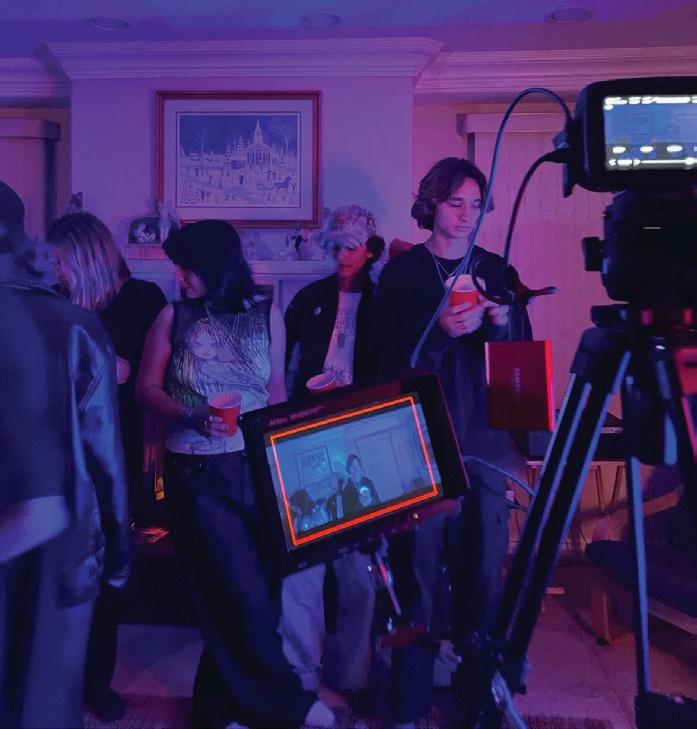
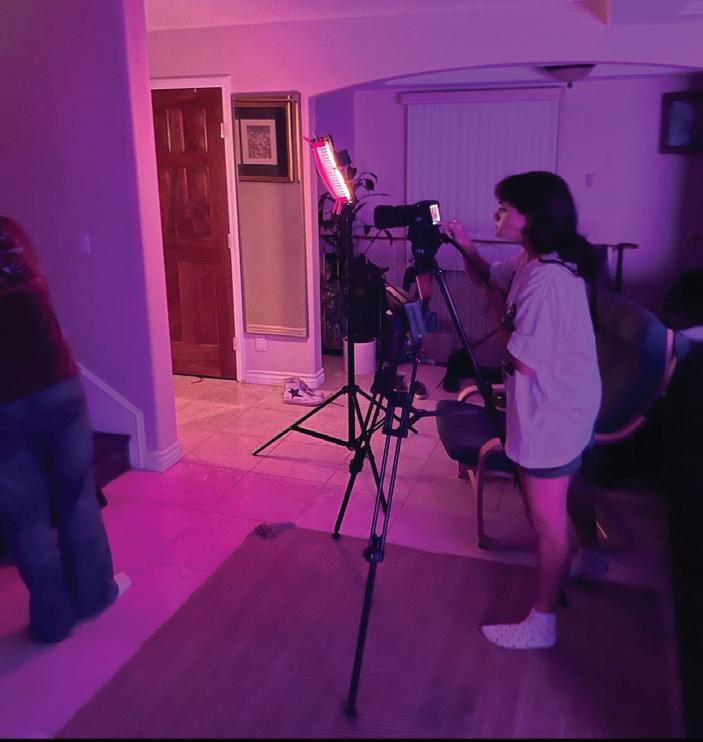
In addition to editing, one of the biggest chal lenges in flm making is “conti nuity and having people on a set not let their emo tions get in the way,” Taubkina said.
“When you're directing, if you're having a bad day, you can't really let that get to you. And you have to fnd a middle ground be tween not being too bossy and also making sure you get across what you want,” Taub kina said.
The students dealt with the challenge in making sure things run smoothly on set. However, they believe the struggles paid of, since the flm aired to the school and, according to both girls, was a great way to
bring up such a central topic.

Transitioning from a small digital cam era to the school’s more advanced equip ment, Appleton has utilized more advanced flmmaking tools as she’s progressed with further assistance from some of Taubkina’s resources. The girls frequently worked to gether, and were “defnitely uplifting each other. Somebody had one idea and then the other one built up on it,” Alisa said.
Both girls have had unique journeys with flmmaking, with Appleton only start ing this past year recreationally and Taub kina having educat ed herself in flm since she was eight years old. However, both directors want to pursue flm as they venture beyond high school.
“I do it for my self now,” Taubkina said. She has exper imented with flm since she was young, taking courses on it in Russia, transi tioning to the New York Film Academy, and spending time at the Los Angeles County High School for the Arts before her attendance at Redondo.
“I feel like literally, I grew up in editing and the technicalities, but also I feel like being older now and processing my trauma
more allows me to show that more easily in my flms,” Taubkina said.


Believing that struggles with mental health are personal and relatable, the girls fnd them interesting and “surprisingly easy” to portray. The way clips are shot can portray certain messages, and the editing process as a whole allows flm artists to be very “subjective,” Taubkina said.
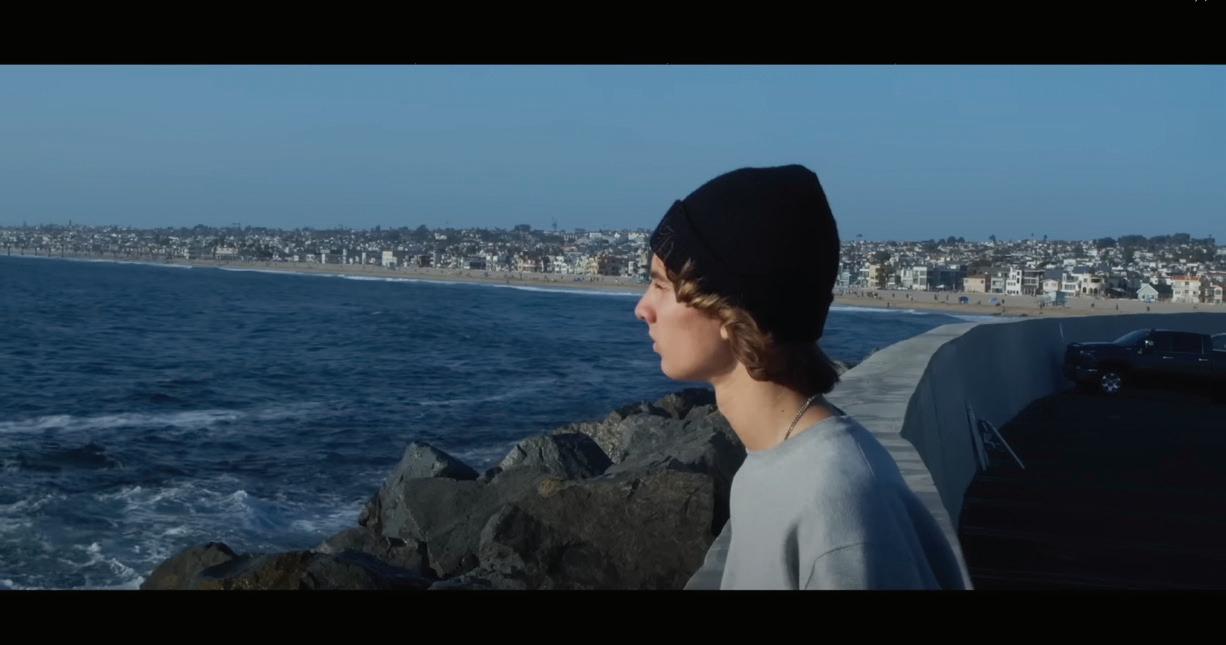
Both student directors have become more comfortable with posting their proj ects publicly, for many to see. Appleton has created multiple Instagram accounts where she displays her proj ects, as well as a new up and running web site. Though these platforms are used as “freelance,” Appleton still wants to work on the promotion of her projects. Taubki na has also begun to transfer pieces from her personal port folio onto Vimeo, as a way of getting her projects out in the open.
Regarding anoth er joyous aspect of flmmaking, Taubki na says she admires getting to “portray struggles and make it look pretty. Even though it’s stressful, cre ating the flm and even getting validation from those who view the movie brings me joy,” Taubkina said.
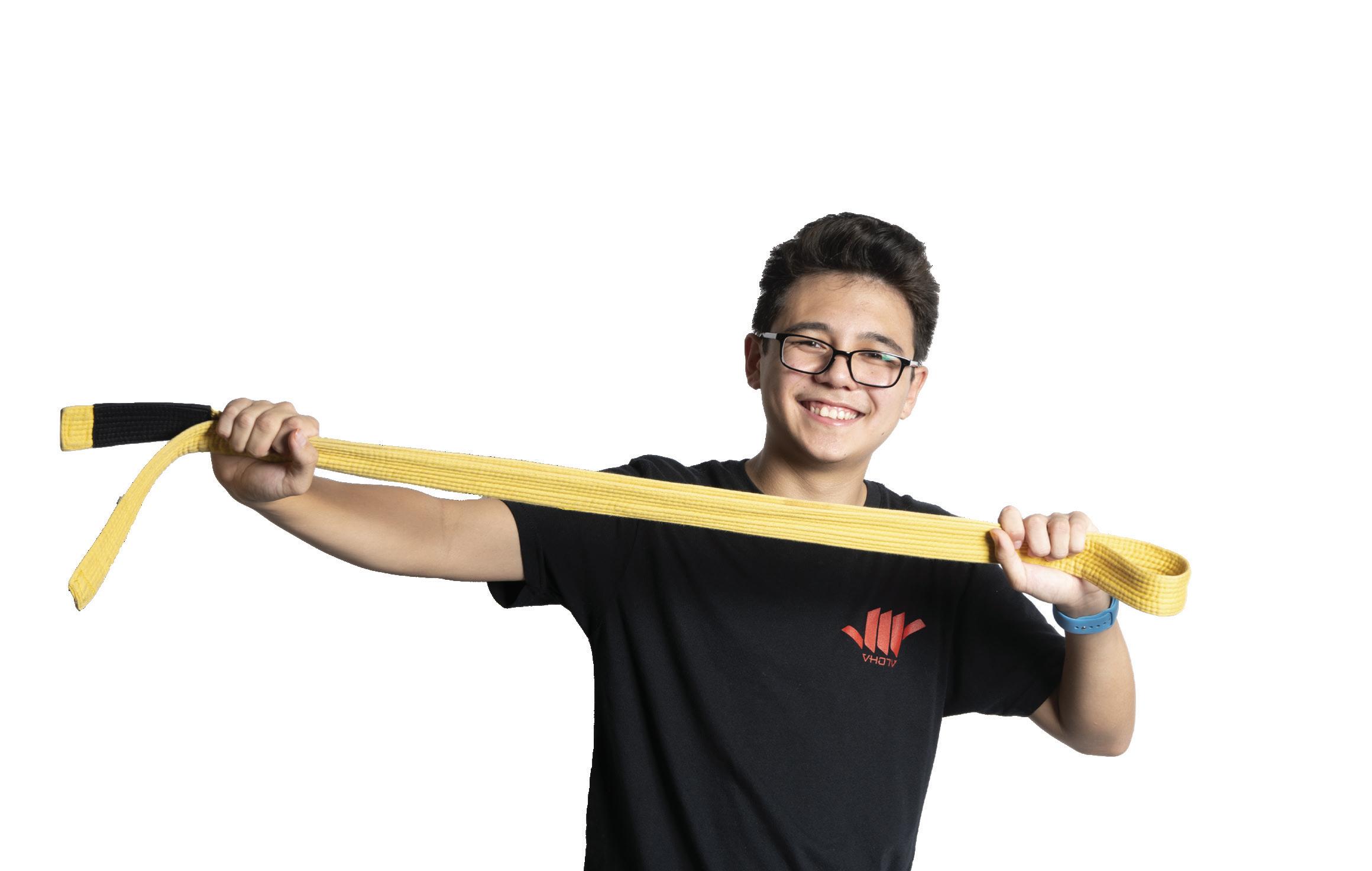 by Isabella Kohler
by Isabella Kohler
For sophomore Alaka’i Jellings, peace of mind comes from putting on his gi and sparring his oppo nent. All of his worries fade away as he be comes fully immersed in the moment.
“People talk about mindfulness a lot, you know just realizing this position that you're in. I feel like jiu-jitsu really helps with that because you have to focus. You have to be in the moment. You learn all these techniques and all these tactics, but as soon as you get on the mat all of that goes away and it's all instinct. It's the most in the moment I think I've ever been," Jell ings said.
Although it has been almost two years since Jellings tempted his fate on the mat and sparred his op ponent, his love for jiu-jitsu runs deep and is never -ending.
“I don't want to be in close contact with people be cause of COVID-19. But I’m still very passionate about Jiu-Jitsu. I love it. I think it's one of the best things I've done in my entire life. When people ask me, 'What is [your] favorite thing to do?' I say, 'Jiu-jitsu. It's just amazing. I love it,'” Jell ings said.
What is now a lifelong passion began simply as an idea from Jelling’s mom to fll the spare time that he had after school.
However, it soon became something more. Jellings continued to learn about the art of jiu-jitsu and even assisted new kids.
“He started when he was six years old. We were trying to look for a physical activ ity for him to try. He was such a little guy so jiu-jitsu seemed like a good one to try. It took years for him to win a single sparring match during practice, but he never gave up,” his mom, Kelly Jellings said.
Jellings feels that the constant failure taught him valuable lessons and helped him learn and improve and eventually win a match.
“I started when I was really, really lit tle. And it was really hard. I didn't win a sparring match for years but I'm glad I didn't quit. I'm glad I stuck with it. I'm glad I didn’t win a
pened to me and that I didn't win for so long that I was able to build up myself,” Jellings said
Jellings is currently a yellow belt in jiu-jitsu, placing him at an advanced inter mediate level. Although long time practic ers of karate and other martial arts typically have black belts, this cycle is very diferent in jiu-jitsu and much slower.
“When I tell people that I have a yellow belt in jiu-jitsu they’re usu ally not very impressed because in karate and taekwondo you level up belts very fast. But in jiu-jitsu it's a much slower process. It takes about four years or more to get to a yellow belt, which is where I'm at
right now. But it obviously took me a little longer to earn due to my break. So it takes a lot of work to work your way up,” Jellings said.
For Jellings, jiu-jitsu is about living in the moment and getting as much practice in as possible in order to be successful in the sport. He doesn’t see it as an extreme competition and this is refected in his re luctance to compete in tournaments.
“He never wanted to compete so he has never done a single tournament. In seven years of Jiu- Jitsu. No competitions. Just training and practice,” Kelly said.
He hopes to be back on the mat by next school year if COVID-19 doesn’t have a re surgence in order to continue practicing and learning about his undying passion for the art of jiu-jitsu.
match for years because, you know, it helped me get through the rest of it. When you start winning matches it feels good. It's like, hey, I'm getting better from losing those matches. That feels really good. So I'm glad that it hap
“I never want to quit jiu-jitsu because one thing I love about it is with boxing and other forms of martial arts, everyone talks about when you're past your time and you can't really do it anymore. You're not as good. But with jiu-jitsu, I've had coaches come in that are red belts, one of the high est ranks you can get. They're like 80 years old and still some of the best Jiu-Jitsu com petitors on the scene. And they're old, their bodies don't work as well, but they're still able to absolutely dominate the mat. It's amazing," Jellings said, "So, I want to be doing jiu-jitsu up until the point I die.”
Cooking, cleaning, doing the laundry and dishes, fnishing homework and if there’s some time left, studying for that AP Gov test.
That’s all one night’s work for anon ymous senior Taylor, who takes care of their family due to their father and broth er’s disabilities. Taylor’s brother has au tism while their father has spinal and heart problems, leaving him nearly un able to walk.
“Because I have to look out for [my fa ther and brother], I have to take on a lot of work, which includes parenting myself and my brother,” Taylor said. “It’s also hard to deal with my own physical and mental health because I lack the time to properly address it.”
According to a 2017 study by the Disabili ty and Health Journal, teenagers taking care of disabled parents tend to be more frustrated and stressed, have a height ened sense of maturity and sometimes lack the proper attention they need depending on the parent’s condition.
This holds true for Taylor, whose respon sibilities mostly involve helping their family around the house to “do anything that [they] can to help make life easier for [their] broth er and father.” While they sometimes get outside help from their mother and other family members, because their parents are divorced and live separately, Taylor bears most of the responsibility alone.
Taylor began taking on these responsi bilities at six years old when their father’s health complications began. Since high school, “things have only gone downhill” as their father’s condition worsened.

“I have had to take on more responsi bilities around the house ever since I was young because my dad had difculty doing simple chores. That put a lot of pressure on me as a child because I didn't receive the parenting that I should have had, and I had trouble functioning because of that,” Taylor said. “It’s harder now since my dad can take on even fewer re sponsibilities, so as time has gone on, I have had to do a lot more.”
According to Taylor, this work takes up most of their time and en ergy, leaving little room for them to have a social life and making hon ors and AP classes more difcult to balance.
A 2016 study from the Univer sity of North Car olina found that teenagers with less active social lives like Taylor are more likely to have an unhealth ier blood pressure, more abdominal fat and higher infammation, a sign that stress hormones have reached chronic levels.

“It’s hard because I want to be in volved, but I can’t be,” Taylor said. “I was
by Sara Miyake-Singervery active in [an extracurricular] but I’ve had to miss so much. In terms of academ ics, I feel like I don’t have enough time to study because I’m so preoccupied. I’m glad I can help my family, but it’s unfor tunately stunted me academically and so cially.”


Similarly, junior Melina Mehta has had to bear increased responsibility due to family needs. Melina’s older sister senior Siena Mehta has a genetic multisystem disorder called Prader-Willis Syndrome, which causes weak muscle tone and learn ing disabilities. Melina and her family share the responsibility of taking care of Siena, helping her with homework, cre ating a food schedule for her and helping her with mobility.
“My whole family is glad to help, but we’re all very stressed,” Melina said. “I’m particularly concerned about the future. I’m going of to college soon, so it might get even more overwhelming for the rest of my family since there’s going to be one less person who can help.”
Although her parents are “very good aout giving [her her] own space and time,” Melina occasionally has to take on last-minute responsibilities like helping to feed Siena and making sure she doesn’t accidentally injure herself.
“Sometimes, I have to stay back and cancel plans to take care of my sister alone since my parents need a break or have oth er commitments. I totally get it because my parents need their own time, but it’s stressful because there’s a lot of extra re sponsibility that falls on me,” Melina said.

Even though Taylor and Melina fnd that having disabled family members can be challenging, they are willing to take on added responsibility for their family nev ertheless.
“It’s very taxing, but I’m glad to do it,” Taylor said. “I love my family, and I’ll do whatever it takes to help them out.”
Hours of school, with agendas flled with homework and dead lines, and hours of working to get a paycheck. For many, the motivation to get a job comes with thoughts of college resumes or just pocket money, but for oth ers, it’s the only way they can be fnancially stable.
Being one of many students who choose to take on a job, senior Jocelyn Cost works as a Recreation (REC) leader at Beryl Heights Elementary School. Cost’s initial motivation for this occupation came from her personal interests and ambitions.
“[I was interested in] getting this job [to get] experience, so that when I apply to college, I'll have something to make me more valuable, and [secondly], to be fnan cially independent,” Cost said. “Also, in my future, I thought about working with kids as a teacher, so this job is a good opportu nity for me.”
Cost works Tuesdays, Thursdays and Fridays for two hours at the REC center. She also worked at Seaside Lagoon for a brief period and, during this time, she carried both jobs, adding up to an 18 hour work week.
“I mainly support myself. [My money] is going into my college fund because I know that if I were to go straight to a four-year college after high school, it would fnan cially cripple my family,” Cost said. “I'm trying to avoid that by working as much as I can without overwhelming myself.”
Despite her flled schedule, Cost found a routine in which she can balance both her academic and work life.

“There are some times where I'll have an assignment due the same day of work, and I'll ignore it until I can actually get of work. In all of my classes this year, I’ve been having a hard time focusing,” Cost said. “I have my weekends free for home work and keeping my social life balanced, but I’ve started working Fridays because REC is understafed, which means I am a little stretched thin.”
Diferent high school students work for diferent reasons, but patterns are often found in issues surrounding pressure and balancing academic, social, emotional and work life. According to the Association for Su pervision and Curric ulum Develop ment (ASCD), a study of over 12,000 students in grades 8-12 found that “as students work more hours, their grades de cline.” Accord ing to the survey, this statistic applies to all students “regardless of their race, gender, so cioeconomic group or academic ability.” Stu dents have to fnd dif ferent ways to balance their responsibili ties with their school work, with Cost using her free 6th period to focus on academics.
“I am a procrastinator, so what has helped me [to focus] is taking advantage of school time. I know a lot of teachers like to [assign] a bunch of classwork and then [assign] homework after, which is a struggle, and it does take up a lot of [my] free time,” Cost said. “I had some serious work-life balance issues during COVID, where I felt like I was working [all the time]. I didn't come out of that until I got
my [time] structured.”
Similar to Cost, senior Caitlyn Hase broock has chosen to work through her senior year, taking up a job as a front desk receptionist at West End Racket and Health Club.
“I'm a senior this year, and it was time to start picking up some more responsibil ities,” Hasebroock said. “When I graduate, I want to support myself so that, if I end up moving away from my family, I have a [fnancial] foundation to start of with. I also want to have more time to do fun things during the sec ond semester, such as prom or school plays. I’m working a lot right now so that I can [lat er] be able to take of some of the responsi bilities at work.”
Hasebroock de scribes some days as “mentally draining,” as she works four to six hour shifts once or twice during the school week, and both days on weekends. In total, her schedule av erages out to 14 hours per week.
“I'm lucky I have a job where I can get some of my home work done. I know a lot of people have a job where they don't have a place to sit down and do home work,” Hasebroock said. “[However], there have been times where I just have to lay down because I'm like, ‘This is too much.’ It’s a lot of stress because [I] have to keep track of a lot of things.”
As an employee at Pure Beans Cofee, senior Una Meidav also experienced the mental pressures and strains of balanc ing responsibilities, feeling “less present, more rushed and more stressed.”
“During the frst month, I worked four days a week with four to fve hour shifts and loved it because I didn't want to work less than that. My parents told me I should because I hav en’t been focusing on college applications and school as much, and also because I have four AP classes,” Meidav said. “Even though the job didn't stress me out, the time it took was too much.”
Meidav has tried her best to fnd a bal ance between school and work responsibilities, but still fnds aspects of her life “being omitted.”
“I can't balance everything. Lately, be cause of how overwhelmed I've been, I’ve put social life more into nights and week ends,” Meidav said. “Volleyball used to be one of my main focuses. I still practice, but very rarely do I put my full energy into it. I used to do other things like reading books, doing art, going to the beach, hikes—all of those enjoyable aspects [of life] have dropped lower on my [priorities].”
Many students put in the efort it
takes to work a job, but some aren’t aware of the academic benefts it can bring, as it can also count as an elective grade. P.E instructor Matt Ballard works as a man ager of “Work Experience,” a program designed as a way for students to obtain school credit while they work.
“There’s a lot of students working, so it’s a way for them to maximize their own time and their schooling,” Ballard said.
With only 13 students in the class, Ballard helps them earn the 5 credits giv en with every 180 hours each individual works.
“I've been teaching them about responsi bility and work ethic, and we do everything for the class online.
There’s a lot of logisti cal things they do, like the schedules of their work, recording hours and organization,” Ballard said. “We do an online discussion where they talk about diferent things re lating to a work en vironment, and we’ll do assignments like learning about labor laws.”
Ballard recogniz es the mental and emotional struggles associated with hav ing a job, especially since workloads difer among students.
“Not all employ ers recognize that kids are students, too. That’s not their priority. Their priority is their job and making money and their [employees],” Ballard said. “Students have families, they have school and a job so it's just one more thing to juggle.”
In some cases, juggling responsibili ties can become almost impossible and sacrifces have to be made. Senior Sophia Warner, who has worked as a cashier at Redondough since January of 2021, had to let go of other aspects of her life in order to take on the job, forgoing her sport for senior year.
“I defnitely have had to sacrifce a little bit; I wasn't able to do tennis this year like I have in the past three years. It's just hard to fnd days of from my job, and the [two schedules] were incompatible,” Warner said. “I also wanted to be in the musical this year but, unfortunately, there would be even more schedule conficts so I wasn't able to do that either.”
According to Warner, having a job has its difculties in terms of stress, but is still a great way to learn about fnances and be prepared for the future.
“Learning how to be fnancially respon

Not all employers recognize that kids are students, too. That's not their priority. Their priority is their job and making money [...] Students have families, they have school and a job so it's just one more thing to juggle."
MATT BALLARD MANAGER OF "WORK EXPERIENCE"
[My money] is going into my college fund because I know that if I were to go straight to a four-year college after high school, it would fnancially cripple my family."
JOCELYN COST SENIOR
“
students grapple mental and consequences of responsibilities surrounding academic, family life
ollege applications—a race by applicants to fll tedious and expensive forms with good grades, deeds and accomplishments. A go-to bump for these applications?
Clubs.
RUHS has 107 of them: Biology Tutoring, Red Cross, Surfrider Foundation. What do these all have in common? They serve to help people and the community at large.

The question surrounding service-oriented clubs: Is it ethically sound to create or join a club that exists to embel lish a college application?
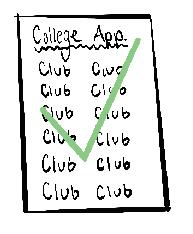
The inherent peer-competitiveness of college-apps means an advantage in extracurriculars could be the de ciding factor in acceptance. I choose to err on the side of “So what?” So what if a club exists for an admissions re viewer to see but feeds the homeless or tutors students who are failing a class? So what if the reasoning for the club is shallow? So what if it helps everyone involved in some way and hurts no one? I see it as a morally ambiguous but acceptable trade-of. In short, a win-win.
An indirect efect of “do-good for the community” type clubs is socialization. Interacting with strangers from dif ferent walks of life is bound to improve conversational and
Cinterpersonal social skills. In other words, conversations outside of routine and comfort build self-confdence with speaking. Putting yourself into a position where you're forced to learn about diferent experiences also helps avoid unfounded assumptions and minimize how often judg ment is passed at frst glance. If someone is homeless, it doesn’t mean they are a drug addict or gambler who lost it all. In the future, this could lead to a person helping an other whereas they wouldn’t have before because of their preconceptions.
Clubs designed for applications don’t signify low-efort activities. The entire point is to improve an application- a mediocre attempt at that won’t cut it. Students are moti vated to be impact ful, maybe not be cause they feel ethically driven to help but because they don’t want to see their eforts be for nothing. If any thing, it is good that they are more moti vated to succeed to get into college be cause they don’t have an inherent desire to help.
Helping inspires
helping; when students see their classmates making a dif ference in the community, it inspires them to support the change they see. That action motivates others to take ini tiative and start or join their own clubs. Whether or not solely for altruistic reasons, that initiative continues the cycle of service.
There are arguable reasons that make it unacceptable to start a club for a college application. Some would say it reduces the action's real value and encourages helping people only if there is something to gain. And yes, that is true, but it is acceptable because at its core it still helps those in need. If you ofered a starving homeless person food, do you think they wouldn’t accept it because the ofer may not be from the kindness of your heart? In my mind, an action that starts of selfshly can also lead to newfound passion with true value in the future.
Whether a club exists to be praised on a college applica tion or not, I choose to look at the tangible real-life benefts of action, and from my count the pros outweigh the cons 4 to 1. It helps everyone and hurts no one, builds social ization and interpersonal skills, corrects prejudices and keeps the cycle of service spinning. All of those take pre cedence over the ethical question of doing the right thing for the wrong reason. If you disagree, you’re more than welcome to start a club for all the right reasons.
ILLUSTRATION BY SCARLETT MISCHEy initial reasons for getting a job were simple: mon ey, money and money. The obvious problem with this is that in order to get a lot of money you have to work long hours. This can be especially challenging as a full-time student, but it ends up being a rewarding experience.
When teens work they learn how to manage their money and develop communication skills. It’s important for teenagers to expose themselves to these life skills early on because it will make the otherwise harsh transition into adulthood a lot smoother.
High school students often work part-time at minimum wage jobs, which means it’s crucial to learn how to spend and save what little money you have. This comes in handy when you’re older and have to make bigger pur chases, like a car or house, so you’ll be able to aford those things no matter how much money you’re actually making.
I started my job at Capri Gelato and Cofee Bar (formerly Paciugo) last summer and I have to say, it was

Mone of the best decisions I’ve ever made. My job pays me a decent amount of money, but my paycheck ultimately gets cut in half during the fall and winter when business is slow. Since I didn’t have as much money, I had to learn how to give myself a budget that would allow me to spend freely without getting too out of control. When I budget I try to cut down on mindless shopping things like ordering food out even if I have food at home or buying new lip products when I already have about 10 in my drawer I don’t use. Having these organization skills now allows me to buy little things I want but still have enough money to go to multi ple concerts a year.
I will say that if holding a job is too stressful and it interferes with school, then that defeats the pur pose of working entirely. You won’t be able to learn any of the lessons you’re supposed to if the only thing you do at work is stress about everything. In order to pre vent this, you have to learn how to communicate your needs. You have to learn how to communicate with your bosses, your parents and most importantly, yourself. You have to learn how to fgure out your boundaries and create a balance that works for you.
Communicating with customers is probably the
Ijust wanted to send a comment about the Hispan ic Heritage article [from Issue 2]. I am the co-chair of the World Languages and Cultures department. We are excited to have our students and the Cervantes Honors Society mentioned in the newspaper. It is im portant to support and educate all students in order to celebrate diversity. However, the article further proved that we need to explain the diference between heritage and nationality. It would be important to clarify to the High Tide staf that nationality is where someone is born and possibly holds their passport. Their heritage is where their family is from and their culture. The ar ticle misinforms your readers. Many of our students at
school are proud native speakers and heritage speakers of Spanish. They are American students of Latin (from Latin America) and Hispanic (Spanish speaking countries) her itage. Miguel González is in fact an American-born stu dent of Mexican and Salvadoran heritage. Marco Foster is the president of the Salsa Club. The article further proves that even a thorough interview needs to be fact checked so that all parties are accurately portrayed, described and presented. We would love to have you come to Día de los Muertos and ask anyone to explain where the holiday comes from. The introduction to the article of Hispanic heritage was ofensive and stereotypical. We can do bet ter than describe maracas and spicy foods. Please stop by Room 403 for any guidance and hopefully we can avoid perpetuating false ideas and a “maraca” soundtrack. Thank you.

hardest challenge in my opinion. With customer ser vice, you will inevitably face a disgruntled customer. A lot of times they’ll be annoyed or angry and they’ll take it out on you. The communication skills you learn on the job help you to speak to the customer in a way that won’t upset them and solve the problem as quickly as possible. I now know how to not take it person ally when a customer is unsatis fed.
Working as a stu dent opens the door to many oppor tunities that will better prepare you for the real world.
ILLUSTRATION BY CRISTINA COUCHThe High Tide encourages a variety of perspec tives from students and staf. If you have an opinion about one of the articles, letters can be sent to the editor at hightideonline@gmail.com
We reserve the right to edit for content, gram mar and space constraints. Letters must be signed and are not guaranteed to be printed. Please keep letters to a maximum of 250 words. Longer guest opinions are also accepted.
In the Issue published on Oct. 7, there was incorrect information in the story titled, "Viva la Cultura!" on page 5. The president of the Salsa Club is Marco Foster, not Miguel González. And Miguel González did not move to the US from Mexico; he is in fact an American-born student of Mexican and Salvadoran heritage.
 by Daniella Gross
by Daniella Gross
While my mom was on a walk to the grocery store with my brother, a woman stopped abruptly in front of my brother's wheelchair, staring into his eyes with confusion and disgust. In the awkward silence my mom asked, “Isn’t he beau tiful?” to which the woman responded “No, he’s ugly.” The lack of empathy in society sometimes gets to me.
When I walk in public with my broth er, all eyes are on him. People don’t know how to act when they see a teen the size of a toddler in a wheelchair making loud grunting noises or happy squeals. They don’t know that staring at him pro fusely makes us uncomfortable. Being low profle with him in public is almost impossible.
Growing up beside my 12-year-old brother Niko has never been easy. Niko sufers from a rare disorder called Kabu ki Syndrome. If you haven’t heard of it, I’m not the least bit surprised.
Kabuki Syndrome is an extremely uncommon disease, with only one in 32,000 children diagnosed in a gen eral population and is often defned by the unique facial features that Kabuki kids are born with, which resemble the makeup that traditional Japanese Kabu ki Theater performers wear.
My brother, being that rare one child in 32,000, was diagnosed with Kabuki three years after his birth.
Niko has a variety of symptoms, the most prominent being an aortic valve dysfunction, dysautonomia, neurologi cal dysfunctions, neurostorming and be ing non-ambulatory and nonverbal. The list goes on and gets added to constantly.
But when others see people like my brother, they are always quick to judge, or are empathetic in all the wrong ways. They either don’t see that despite the pain he sufers from, he is always happy, or they don’t treat him like a normal hu man being, confning him to his limita tions instead of seeing his potential.
At school, I constantly cringe when someone calls a peer a cripple or retard ed. People don’t fnd it ofensive and think it’s just a hilarious way to make fun of their friends. They don’t under stand it’s a derogatory term used against the disabled community, directly insult ing those who need extra help physically or mentally.
As the sibling of a special needs child, it can be challenging. I often internalize the struggles I face at home with Niko, as not many of my friends are able to re late to my situation. When my parents are busy, I change my brother's diapers, dress him, do his laundry, feed him, give him medications, brush his teeth and take him on walks. I help as much as I can because he isn’t able to do simple tasks.
For all my responsibilities, though, the most mentally challenging thing about being a sibling to Niko is having to watch him in pain. His neuro storms— [A hyperactive response of the sympa thetic nervous system, in most cases caused by TBI]—are painful and last a week, occurring every two weeks.
This is why it pains me when instead of treating him with curiosity and inclu sion, people treat him with disdain and disgust. To me, my brother is perfect in every way; he’s all I know.
Niko likes ice cream and pizza, but hates vegetables. He likes peaceful walks in his wheelchair and enjoys music. When I sing him to sleep or tuck him in, he shows his love by giving me the biggest hug anyone could ever imagine. At the end of the day, he is just like you and me. If people could see what I see instead of assuming and judging by how he looks, they would see a beautiful boy.
Business Review describes using fller words as a way to “hold the conversational foor” while one is thinking, so if non-male individuals are more likely to be inter rupted, reducing paus es in their speech is a defense mechanism against losing speaking time.
It is harmful but far too common to associ ate stereotypically fem inine traits—spending more time on one’s ap pearance, enjoying shop ping for clothes, watching romantic TV shows and yes, using “Valley Speak”—with a lack of intelligence.
It’s like, so annoy ing when linguis tic purists impose their prescriptive gram mar dogma on the speech pat terns of the masses. Cuz like, language is a constantly adapting and ever-changing construct we use to describe our unique experiences, and like, why do we listen to those elitist academics when they tell us how to speak? Gag me with a spoon!
It’s hard to go a day without hearing “like” sprinkled throughout speech. De spite its ubiquity, the improper “like” is widely considered to weaken someone’s credibility, making them sound unsmart or unassertive. The reality, though, is that “like” shouldn’t be viewed that way; fller words certainly do suggest a lack of conf dence in what one is saying, but to construe “like,” as it exists in today’s lexicon, as fller per se is false.
Traditionally, “like” means to fnd something attractive or be similar to something. The slang-usage of “like” has other functions: quotative (“I was like, ‘____’”), fll er, hedge (to indicate am biguity), cushioning and as a discourse particle (to emphasize). “Like” has become its own complex pillar of today’s grammar.
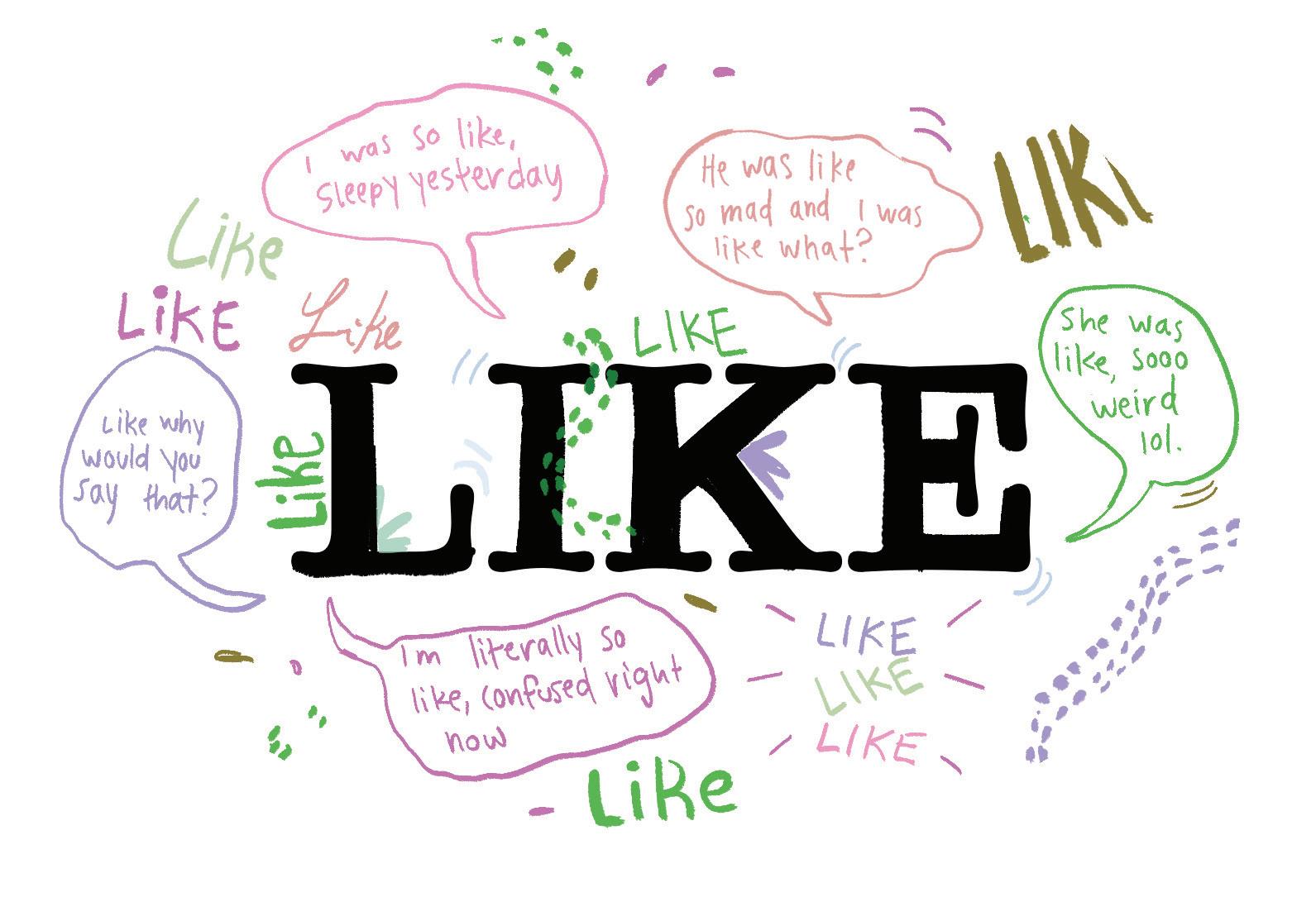
If inserting “like” into a sentence really is just the hesitation of an unsure speaker. It wouldn’t afect the meaning. And yet, it does. “They have 20 billion dollars” is difer ent from “They have, like, 20 billion dollars,” because it indicates the ambi guity, approximation and/or hyperbole of the statement. “Like” is a modal marker—a grammatical cue that indicates degrees of reality or truth.
Prescriptive linguistics refers to the rules for how language should be used according to the most pretentious folks in academia (as opposed to descriptive linguistics—how language is actually used). So, following the prescriptive agenda would lead one to scof at the perva sion of “like” throughout twenty-frst century English, for it is
not within the canonical rules of English.
Today’s informal use of “like” frst emerged with the Beatniks, a 1950s coun terculture movement, but it was popular ized in the 1980s with the Valley girl ste reotype. In 1982, Frank Zappa produced the song “Valley Girl” with his daughter, Moon Zappa, poking fun at the material istic, young, upper-class, White women of the San Fernando Val ley. In the song,
Not to mention, those speaking English as a second language may use “like” more often to gather their thoughts in a language they’re less familiar with. Following prescriptive linguistics “almost always has an aspect of social gatekeeping,” according to the University of Pennsylva nia, in that “arbitrary features of language are used to block social advancement.”
Weaponizing someone else’s use of “like” is simply a contrived way to demean them, and it’s no coincidence that this is done so often against women and non-native speakers.
It is true that academic or professional writing and even speaking warrant more formality than “like” suggests, but acting like it reduces the elegance of the English language
satirically blabs about, “like, the Galleria, and like, all these really great shoe stores.”
Even though the mocking of “like” was frst directed toward the wealthy women of Southern California, it is inher ently problematic to ascribe intelligence level to any language pattern. With “like,” the efect of that can lean into misogyny. An online article published by "The At lantic" called “Actually, Literally, What Your Crutch Word Says About You,” as cribes saying “like” to meaning that “you are a teenaged girl who smacks her gum a lot while talking and, like, OMG, can you believe you said that?” Although most can’t avoid at least the occasional “like,” the poster-child of apparently dumb “like”-sayers is undoubtedly a teen girl. Why is this word, which many associate with being a superfcial air head, attached to teen girls so often?
One of the most common usages of “like” is as a fller word, which may explain why the reigning image of those who say “like” is female. Research by Northwestern University has found that in professional and personal conversations, women are interrupted more than men. The Harvard


status quo; it’s the natural course of things. ‘Kids these days’ will al ways create their own distinctive ways to move through the world.
Language plays a central and vital role in the human experience and thus is not spared from generational changes.
In the 1600s, “thou” was the stan dard, but today seldom does a modern per son address another as “thou.” According to the University of Pennsylvania, “Genera tion by generation, pronunciations evolve, new words are borrowed or invented, the meaning of old words drifts and morphol ogy develops or decays.” New language is nothing new. The way “like” has been transformed to encompass so many mean ings and nuances is not a disaster; it’s evo lutionary linguistics happening in our own lives.
Attempting to stymie the inevitable changes in language is futile and foolish. The constant evolution of language is in fact one of its most unique beauties, not a herald of its downfall.
So like, let’s embrace it.
LOLA DIEHLThe constant evolution of language is in fact one of its most unique beauties, not a herald of its downfall.
ELISE HAULUND
"Like" as a fller word is a testament to the constant evolution of language, instead of a downfall of lazy speakers
“I want to hear your heart… because I’m gonna eat it,” Evan Peters said while playing serial killer Jefrey Dahmer. Dahmer whispers this as he lays on the chest of his victim’s beating heart in the frst episode of the limited series “DAHMER” which premiered on Netfix, Sept. 21.
Throughout the frst half of the David Jacobson-directed series, the series depicts the life of Dahmer, from his nightmare childhood to his life sentence in prison. Even though the series delves into the life of Jefery Dahmer chronologically, it also sheds light on the people afected by his gruesome actions. Even though most of Dahmer’s victims are only remembered for the bloody way they died, no one paid at tention to the beautiful lives they lived.
The frst episode starts at the end of the timeline, with Dahmer playing out his last murder attempt. His last victim, Tracy Ed wards, was lured to Dahmer’s apartment when he noticed something of. While the foul stench of Dahmer’s apartment put Edwards on edge, it was Damher’s heart-wrenching remark that sent him run ning for dear life.
After escaping Dahmer’s hotel hell, he fnds the police and tells them Dahmer’s murderous intentions. Once the police in vestigate Dahmer’s apartment, they discov er a box with pictures, showing the disfg ured body parts of his victims. It was truly disturbing to see lifeless bodies dismem bered in just one polaroid. Overall, the frst
episode was thrilling. My heart was boom ing at the suspense of Edward’s escape, as the chilling scene illustrated a tense night mare. Let’s just say I didn’t sleep well that night.
From the blood-stained mattress to the tub of acid decomposing the fesh of his past murders, no detail was left out in the series. Aside from that, Peters gives the performance of a lifetime.
Peter’s performance as Dahmer was very unsettling. His oddly monotone voice and odd mannerisms accurately portrayed the strangeness of Jefery Dahmer. In ad dition to the perfect portrayal of Dahmer’s sinister character, the musical theme throughout the series encapsulates each eerie feeling in every single scene.
Even as the subtle nuances of “DAHMER” kept me hooked, the whole set design was equally incredible and added to the chilling storyline of the series. Wheth er it was Grandma’s dusty old-fashioned house or Dahmer’s “Brady Bunch-like” childhood home, the series brought this 1970s world to life.
While much of Dahmer’s life was de tailed in the series, the show’s sole purpose was not to explain who Dahmer was, but rather focus on Dahmer's impacts to many families. Directors focused on the hypoc risy of the Mawaki police department for turning a blind eye while the black commu nity cried for their help. The series shines a light on Dahmer’s victims by dedicating an hour episode to Glenda Cleveland, de
picted as Dahmer’s next-door neighbor in the show. In that episode, it is revealed that Cleveland called the police station for six consecutive months while Dahmer carried out his back-to-back grizzly murders. The episode calls the blatant racism and ho mophobia exhibited by the police force in the show and real life, as Cleveland’s pleas were ignored with victims falling into the categories of black, gay men.
Niecy Nash embodies the frustration, sadness, and anger that went into this investigation in her Emmy-worthy per formance of Dahmer’s neighbor, Glenda Cleveland.
“I called y’all over and over, a million times, and you know what you did? You did nothing. Now it’s too late. Y’all came too late,” Nash said, as Cleveland, to the po lice ofcers after they arrested Dahmer. It’s important to note that this scene, although powerful, is only a symbolic representation of Cleveland's anger and is not historically accurate. According to Anne E. Schwartz, author of “The New York Times” best-sell ing book “Monster: The True Story of the Jefrey Dahmer Murders,” Cleveland and Dahmer never spoke to each other in real life, nor did they live next to each other. In fact, Cleveland lived in the building next to Dahmer’s. While the series may have ex aggerated some parts of Cleveland's back ground, her perspective is still impactful and moving.
Even though the show dedicated a few more episodes to the victims of Dahmer,
by Ethan Chicritics believe that the show focuses more on humanizing Dahmer instead of high lighting racial injustice. While I do agree that the purpose of the story confates the tragedy of Dahmer’s past with injustice, I do not think the show attempts to human ize him in a major way. Humanizing a char acter means giving them relatable traits. And nothing about Dahmer is relatable.
From the start, Dahmer is depicted as a strange and unaware person whose main interest is drugging and dismembering people. Dahmer was born a killer and died a killer. The show made that clear in the last episode when Dahmer had fashbacks of everyone he killed before he died.
Aside from humanizing Dahmer, critics feel the show feeds into the societal obses sion with serial killers. However, I don’t think this is a bad thing. People are crea tures of curiosity, and the show “DAHMER” explores those curiosities. Overall, I don’t think people are mainly obsessed with Dahmer as a person, but rather interested in the psychopathic nature of a serial kill er. This is why thousands of moms poured their glasses of wine and tuned in to watch Dahmer, and murder shows alike. Who isn’t curious about a man who eats people’s hearts?
Taking into consideration the subtle historical inaccuracy and slight message inconsistency, “DAHMER” is still a techni cal masterpiece, as well as a creepy thrill er that will leave mouth foored and your popcorn bowl empty.
 by Lauren Choy
by Lauren Choy
Dear David O. Russell: I hate to break it to you, but casting tons of famous actors and actresses doesn’t make up for a lousy plot.
As the director of American Hustle and Silver Linings Playbook, Russell un successfully takes viewers along the high ly anticipated journey of a nurse and two veterans who uncover the suspicious death of General Bill Meekins. The frst screen of the movie reads, “A lot of this actually hap pened.” Although most of the characters and plot are made up (including the three main characters), the flm is partially based on the 1930s events that attempted to re place President Franklin D. Roosevelt with a fascist dictator. With too much complex information delivered poorly, the flm was terribly difcult to follow along and had me counting the minutes until the credits.
It starts in 1933 in veteran Burt Ber endsen’s ofce (Christian Bale). He him self has a missing eye from the war and treats fellow veterans with similar injuries. As the flm fashbacks to the war in 1918, he meets his friend Harold (John David Washington), a Black veteran who faces racism daily throughout the flm. Both had many bloody injuries and the nurse who took care of them was Valerie Voze (Mar got Robbie). When the three form a truce to always look after one another, they fee to Amsterdam to escape their problems. The three are the happi est they’ve ever been, but nothing good things can last, and Valerie leaves without a word. The one recurring message I enjoyed was
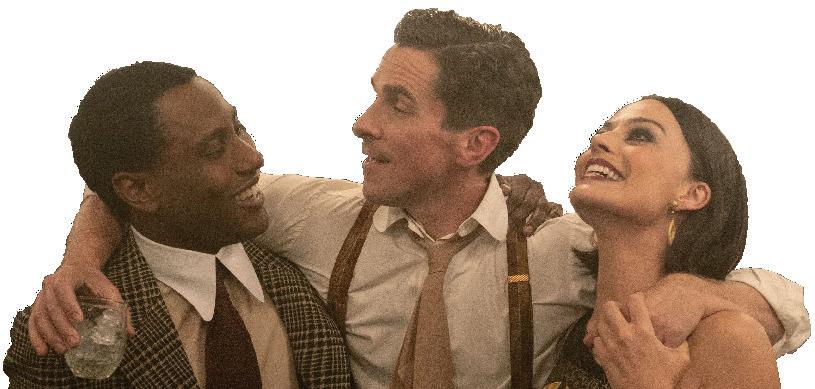
the idea of this tight-knit friendship. Their pact brought out the best in one another and represents the underlying theme of the need for trustable friends.
Flash Forward to 1933, Liz Meekins (Taylor Swift) pleads with Burt and Harold for an autopsy of her father’s — General Bill Meekins — death. Burt and Harold go to autopsy nurse Irma St. Clair (Zoe Saldana) and stumble across suspicious evidence. They meet with Liz to forward her the news, but she’s found scrambling to run away because she’s been threatened. A few seconds later, Liz is dead on the street, and Burt and Harold are framed for murder. As they go to great lengths to prove their inno cence, they stumble across the Voze fami ly, a family flled with connections to clear their names. Not knowing Valerie’s actual last name, the two meet Libby Voze (Anya
Notice not even halfway through this flm review, I’ve already listed more than fve actors/actresses you know: Christian Bale ("Batman"), Margot Robbie ("Wolf of Wall Street"), Zoe Saldana ("Guardians of the Galaxy"), Rami Malek ("Bohemi an Rhapsody"), Anya Taylor-Joy ("The Queen’s Gambit") and of course, Taylor Swift. Russell had every possible opportu nity to make the flm remarkable, yet I’m sitting here failing to picture how each character connects to the next. In my opin ion, the talent was there - in fact, the actors and actresses were the best part of the flm. Every actor and actress played their role to perfection — I never once felt that they weren’t actually those people, yet a movie is supposed to be a combination of all these characters together. The glue wasn’t there, and that’s on Russell.
murder mystery with a shocking ending twist, yet it wasn’t at all satisfying. An un expected ending is supposed to leave the watchers with an “Ah ha” moment. But in stead of an “Ah ha” moment, I got a “hmm” moment. Technically speaking, the turn of events was something I didn’t expect, and I give credit to Russell for his creativity. The big reveal of the murder has arrived, and the climax builds with tense conver sations between Dillenbeck and Tom Vose in an overall nerve-wracking atmosphere. Dillenbeck reveals the murder in front of the whole crowd, a fght breaks out and gunshots are shot, but don’t get your hopes up. The “Ah ha” moment never comes and the delivery of the ending falls fat. Russell jam-packed too many fne details and char acters in a two-hour movie that when I left, I was unsatisfed, to say the least.
Although the majority of the movie wasn’t well-done, Russell’s use of camera angles and color did successfully bring what was an otherwise disorganized plot. I savored how the color symbolism, such as the color red, aroused love and an ger during the most prominent climactic scenes. The lower camera angles immersed viewers into every conversation; I felt as if I was a little kid again, craning my head up eagerly at the big kids. The technical choic es kept me interested, but unfortunately, it doesn’t make up for everything.
The frst thing I did when the lights went back up was yawn.
"Amsterdam" fails to live up to expectations, despite its stellar cast and production

 by Zoe Rossi
by Zoe Rossi
Adreamy escape perfect for all movie lovers, the Rooftop Cine ma Club awaits with fresh pop corn and a festive, cheerful atmosphere. Out of the three locations throughout Los Angeles, the El Segundo location, which opened in March of 2020, is located on top of a parking structure of PCH. This hid den gem is the perfect place for those in the South Bay who are eager to indulge in a Halloween-themed flm this October.
Tickets to see a flm at the Rooftop Cin ema Club in El Segundo go for 20 to 30 dollars. The movie selection ranges from cult flms to classics to new releases. For October, the movie lineup celebrates the Halloween season with flms such as “Fri day the 13th,” “Hocus Pocus,” “Dracula,” “Scream,” “The Shining,” “Bodies Bodies Bodies,” “Nope,” “IT” and “The Blair Witch Project.”
It is easy to check out movie showings and purchase tickets on the Rooftop Cin ema Club website. Guests can buy sodas, popcorn or candy at the concession stand near the entrance, and adults over 21 can get canned beer or wine at the bright pink mini bar. Moviegoers can bring their favor ite cinema snacks and take-out.
For the month of October, the Rooftop Cinema Club features adorable Halloween decor that makes the perfect background for a photo shoot with friends. During December, the rooftop transforms into a winter wonderland with holiday-themed movies, such as “Elf” and “The Grinch.” Guests can also sit and play a game of Jen ga or hang out before the movie in one of the many vibrantly decorated sitting areas scattered around the rooftop. The screen displays trivia questions and karaoke games for those who prefer to sit and relax in their Adirondack chair before the movie starts.
Upon arriving, guests need to check in at the box ofce to receive a personal pair of Bluetooth headphones before picking out the perfect seat to watch the movie. Seating is arranged based on the type of chair pur chased. A singular Adirondack chair costs $24.50, and an Adirondack love seat costs $26.50 per person. Both of these options include a small popcorn. Guests can also opt for an adjustable lounge chair, which is $19.50 or $22.50 with a small popcorn. The rooftop ofers a large, spacious area with plenty of seating, making for a pleas ant, relaxing environment. The staf at the Cinema Club are kind, respectful and help ful if guests come to them with questions.
Since the Rooftop Cinema Club is, well, on a rooftop, headphones are required to enjoy the flm. The headphone provided upon checking in have excellent sound quality, with adjustable volume control and noise-canceling technology, but ex cessive wind may cause some audio static. The screen quality was also clear and visu ally dynamic. However, movies that start before 4:30 PM may be difcult to see due to the sun's glare on the projector screen. It is important to consider the movie start time because guests under the age of 18 are unable to attend movie showings that start after 4:30 PM. This restriction may be an issue because many horror movies are shot dark.
Also, be sure to grab a blanket or sweat shirt before leaving the house. Once the sun sets, it can feel breezy and chilly on the rooftop. Better yet, bring along some hot chocolate to stay warm—it will only add to the festive fall vibes.
Overall, the Rooftop Cinema Club is the perfect way to enjoy any movie and make unforgettable memories. With the luxu ry of fresh air and open space, it's a great place to enjoy a date night, an outing with a group of friends, or a solo excursion for guests who need some alone time. No mat ter the time of year or the movie, guests looking for an escape from the ordinary are sure to fnd whimsical fun at this rooftop getaway.
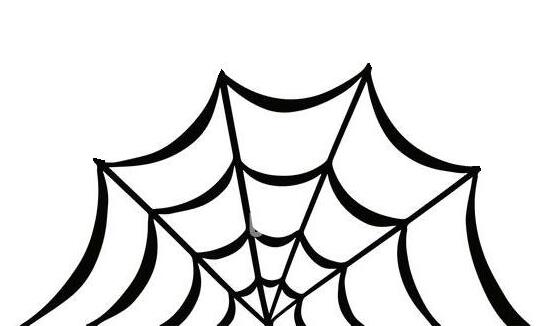
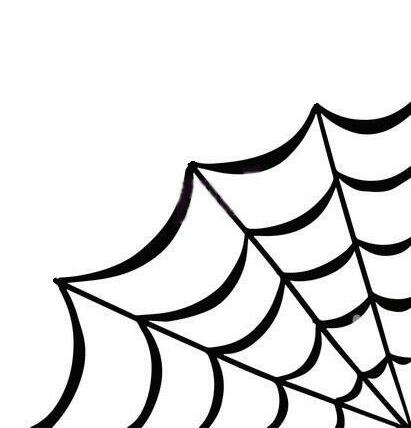


 by Hadeel Azzam
by Hadeel Azzam
It’s the most wonderful time of year again, Halloween. With that comes the decorated store aisles stocked with fake spiderwebs, skeletons and costumes you only wear once. But which store of fers the best of the best when it comes to Halloween supplies? That is the question I took upon myself to answer. I went to three difer ent stores for my research: Target, Party City and Spirit Halloween.


When I walked over to the Hal loween corner of the store I wasn’t impressed, but I also wasn’t disappointed. It is a good middle ground. I was able to fnd anything I need ed there such as face paint, wigs, fairly priced costumes and a singing infatable skeleton. But it is defnitely not the place I would go to if I wanted to go all out for Halloween. The costume section had a lot to ofer—considering it was Target. But it was also disorganized and I almost tripped over one of the taco costumes scattered on the foor. Also, many of their shelves were bare and items were out of stock, but that was mostly their decor items, such as mon ster fower vases or spooky telephones. Target is a last resort if it is October 30th and you don’t want to wait in the long line the other stores are probably hosting, how ever that's only if they keep their stock up.
With all the hype around Spirit Halloween I had high hopes, and I was not disappointed. With a wide selection of Halloween decor for sale they had many of their animatronics out on display, which made the experience a lot more interactive. Jumping in front of them to see what they would do or say was extremely entertaining. There was even one that would grow taller out of nowhere, and it scared me more than I would like to admit. I will say that with kids running around the store trying to see all of them at once, paired with the obnoxiously loud music, all the noise and commotion got ir ritating after a while. Spirit also had home decor scattered around the store, organized by movie or franchise which made my or ganized heart extremely happy. They also had Halloween themed stufed animals and trinkets that can be used year round, like mugs and keychains. The best part though was the costumes that you can grab and go—a refreshing system when compared to Party City. The costumes were also or ganized by franchise and category like the home decor. Many of their costumes were eye-catching and detailed. One in particu lar was an infatable chicken costume that I fell in love with but sadly, I didn’t think my mom would approve of. Alas, Spirit Halloween, like Party City, sold their cos tumes at a high price point, such as $50 for a kids clown costume. Since Spirit is a seasonal store, opening in July then closing as soon as November 2nd, they defnitely take advantage of it and sell their products for more expensive prices than necessary. Overall I would put Spirit Halloween on the top of my list. Despite their high prices, they do compensate for it by having a wide variety of products that you can’t fnd any where else.
When I walked into Party City, I knew there was one thing I was bound to fnd—a costume that ofends at least one culture or minori ty. I wasn’t particularly mad at that, but I was bafed to see a coin hip scarf, tradi tionally worn in Middle Eastern countries around someone’s hips while dancing, la beled as “Mystic Scarf” along with a photo of a woman wearing it around her head. The worst part of all was the photo dis played her wearing it insanely wrong. In the section next to it, among “pimp canes” and fake gold chains with large dollar bills attached, I found a box braid wig. With the awareness in today’s world I thought Halloween stores would at least try to min imize their ofensiveness, but it seemed like Party City upped their game this year. I walked away from it and to Party City’s infamous wall of pictures of Halloween costumes. If you’ve never shopped for your Halloween costume at Party City, a majori ty of their costumes are displayed on a wall near the back of their store with a picture of the costume and number. Next to the wall, there is a staf member and you give them the number of the costume you want. The staf member then gives the number to another member who resides in the back of Party City where all the costumes are stored. The second member takes it from storage, and calls out your number for you to pick it up from a table at the back of the store. The system has been in place for years and is a complete burden and waste of time. It takes you from one line to tell them you want the costume, to a large crowd where you wait while number after number is called until yours fnally arrives. I can see why Party City enforced this inconvenient system—they do not have the space to display all their costumes for customers to grab. But maybe if they took things like “mystic scarfs” and box braid wigs of their shelves, they could not only make more room, but minimize their se lect ridiculous and ofensive costumes. Not only are these costumes a task to grab, but you are also paying an unnecessary amount for them. I really do not see the reason one should spend $50 for a Harry Potter robe. If any other aspects of the costume were in volved I would get it, but the price for the robe alone was an overkill. Despite every thing wrong with Party City, they did have a range of costumes and masks to choose from and even then it was mediocre at best.

Girls varsity volleyball competed in the Redondo/Mira Costa Var sity Classic Gold Division tour nament against six teams from Friday to Saturday, Oct. 7 and 8. The team played in a best-of-three format, winning fve out of six games and coming in second.
The team stayed ready going into their second game of the tournament after win ning their frst game against Thousand Oaks High School in the frst two sets. They beat Palos Verdes the day before, which helped them in their preparation for the tournament.

“We played a tough match against PV, and I think after that our team just really wanted to up their game,” senior Mele Cor ral-Blagojevich, outside hitter, said.
Redondo took an early 13-5 lead in the frst set of the game, with Redondo’s block ing showing out on defense. The players were ready to defect Aliso Niguel's attacks and stop their spikes from landing.
“I feel our team was defnitely pre pared,” Corral-Blagojevich said. “It’s not really about running crazy plays. We just like to keep it simple.”
As a libero, a back-row defensive spe cialist, junior Summer Suppik constantly succeeded in her position, keeping many rallies alive for Redondo to come back and win the point.
“Everyone relied on each other to do their job,” Suppik said. “I think everyone did a great job staying in their position.”
The players made some strategic plays and hit controlled kills. Winning the frst set with a long rally against Aliso Niguel, Redondo went into the second set feeling confdent after winning 25-17.
“The more you focus and the more you’re
like ‘I want to win,’ the better you do, and I think we were really locked in at that moment,” Corral-Blagojevich said.
Redondo and Aliso Niguel start ed the second set of trading points, keeping the score close. According to right outside hitter Abby Zimmerman, the girls’ remained focused for the rest of the game.
“We always think of the next play. [We] don’t sit on the past. We always want to get one step ahead, one point at a time. Just staying on the next play really helps us,” Zimmerman said.
Redondo controlled the play of the game, coming out strong and covering the court, getting a hand on every ball. The serving and blocking helped them continue to hold their lead against their opponents.
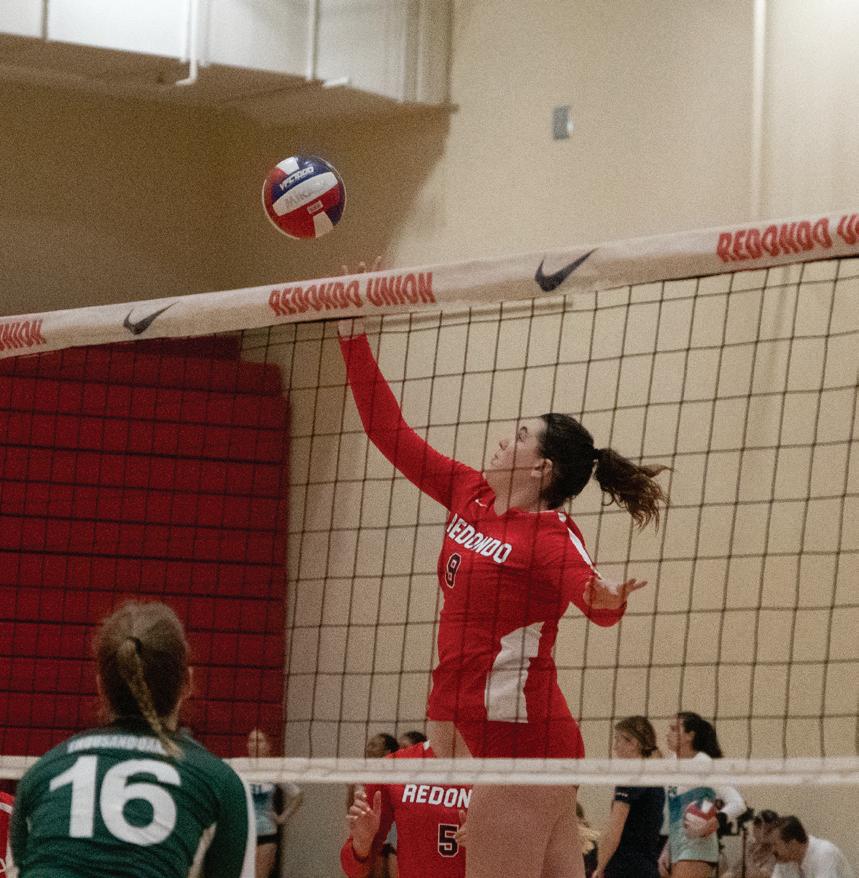
“The biggest thing we focus on in our practices is making sure we take care of the ball. The more we take care of what we can control, the better we do,” Corral-Blagoje vich said.
Redondo led late into the second set, 2319, but Aliso Niguel fought back and closed the score to 23-22. Redondo secured the win after scoring the fnal two points to end
the game of of their blocks.
“It’s our home tournament, ev eryone had this hungry feeling and really wanted to win,” Corral-Blago jevich said. “Physically, we just worked really well as a team and everyone was just focusing on doing their job really well.”
In their ffth league match of the sea son, girls varsity tennis fell short to Mira Costa in a close 8-10 home match on Thursday, Oct. 6. Although Costa has stood undefeated against Redondo for quite some time, number-one singles play er senior Maegan Deng claimed Thursday was “the tightest match against Costa we’ve had in years.”
“Everyone was playing so well. Every one was supporting each other because we were neck-and-neck, so of course, you get really nervous,” Deng said. “We were basically one point away.”
According to junior doubles player Malia Wilken, the girls put up a good fght, focusing on consistency in their basic strokes throughout the match.

“We had good groundstrokes and were hitting [diagonally] across the court. I think we could have worked on our serves a little bit more, but overall we were pretty consistent,” Wilken said.
While the girls’ groundstrokes re mained strong, it was ultimately their nerves that got in the way of victory, according to Wilken.
“It was a rough start in the beginning. I’d like to think we were doing well but we defnitely could have played better,” Wilken said. “I think we found our groove in the last round, but I wish we had gotten there sooner because we would have prob ably won the entire match.”
According to Deng, staying calm under pressure proves to be one of the team’s weaknesses. This often prevents them from winning crucial “pressure points,” highly competitive points played near the end of a tight game that dictates the winner.
“With pressure, I know we hate it. Once you’ve played a lot of pressure points, you start to know how to deal with it, but you’re never going to get used to it. It’s always going to be really agonizing,” Deng said.
Though anxiety was high, so was the girls’ indomitable enthusiasm and team spirit, which helped to energize them before and during the match.
“We have really good team spirit. We’re always cheering each other on and telling each other not to worry—we’re going to do this,” Wilken said. “The entire week I’ve been encouraging the team and say ing we’re going to beat them; this is our chance.”
The team got tremendously close, as the girls played some exceptional points, with top singles players Deng and junior Sidney Cherry sweeping all three of their matches. With a little more confdence, Deng believes Costa “wouldn’t have stood a chance.”
“The team is capable of so many great things. They’re just so good in practice, and I think if they believe in themselves that they can put that into a match, they will do so much better in the matches to come,” Deng said.
Despite their loss, such a close match worked to bolster the team’s confdence and motivate them for their next match against Costa on Monday, Oct. 24, accord ing to Deng.
“I’m really excited because I think that now we’ve gotten a taste of them and we’re getting used to it. We know what’s going to happen. We’re really going to soar better,” Deng said.

 by Sam Schwartz
by Sam Schwartz
Coming of a blowout win, varsity boys water polo was looking to beat their Bay league rivals Palos Verdes (PV). Despite the tough battle for both teams, Palos Verdes came out on top, winning 12-7 on Tuesday, Oct. 11. Redondo played their sixth home game of the sea son, and even though Redondo was excited to play home, they started of shaky with PV scoring three goals in the frst fve min utes, leaving Redondo trailing 1-3.
While they proved a tough opponent straight out of the gate, Redondo tried to prepare for PV’s ofense in practice. senior and co-captain Jack Guenther's prepara tion alone paid of for him, as he scored 2 goals.
“I watched [PV’s] flm multiple times over the weekend. I know a few guys on their team and I looked for someone I could match up with an attack on,” Guen ther said.
Even though Redondo started to pick up towards the end, they were still behind. Nevertheless, Redondo persisted. Right
as the 3rd period ran out, co-captain Jack Guenther got the crowd’s hand to fy up with a buzzer-beater goal.
A few more good plays brought Re dondo back into the game as they pushed through the end of the quarter.
“The frst three quarters were all very intense, but once the fourth quarter hit, PV took the foot of the gas [and we saw an opening],” junior attacker Chris Yook said.
With Redondo's ofense starting to turn the tides, freshman Miles McDaniel got the ball and immediately bounced it in for a goal, putting Redondo on a 3-0 run.
However, the strides Redondo made in the fourth quarter weren’t enough to win the game.
“They [PV] beat us last year. I can’t re member the last time we beat them, they are a pretty good team,” Yook said.
Redondo looks to improve in future games after their lose to PV.
“The defense started to improve on pre venting fast breaks and the ofense started [to] move the ball strongly to the goal and
both will need to continue doing so,” Guen ther replied.
Yook agreed with Guenther that the team needs to work on other factors from
this loss, to help the team rebound for next week.
“Ofensively we need to work on moving the ball around [with more control] and not throwing the ball into the middle, [right in front of the goal to a teammate] where we turn the ball over. On defensive we need to work on not get countered by the person we’re matched up against,” Yook said.
Even though Redondo couldn’t pull of the win, the players’ performances left high hopes for the team for the future.
In the coming weeks, the team looks for ward to climbing up the ranks in the Bay League. With only three more regular sea son games to go, the seahawks creep closer to a winning season, as it would be their sixth year in a row.
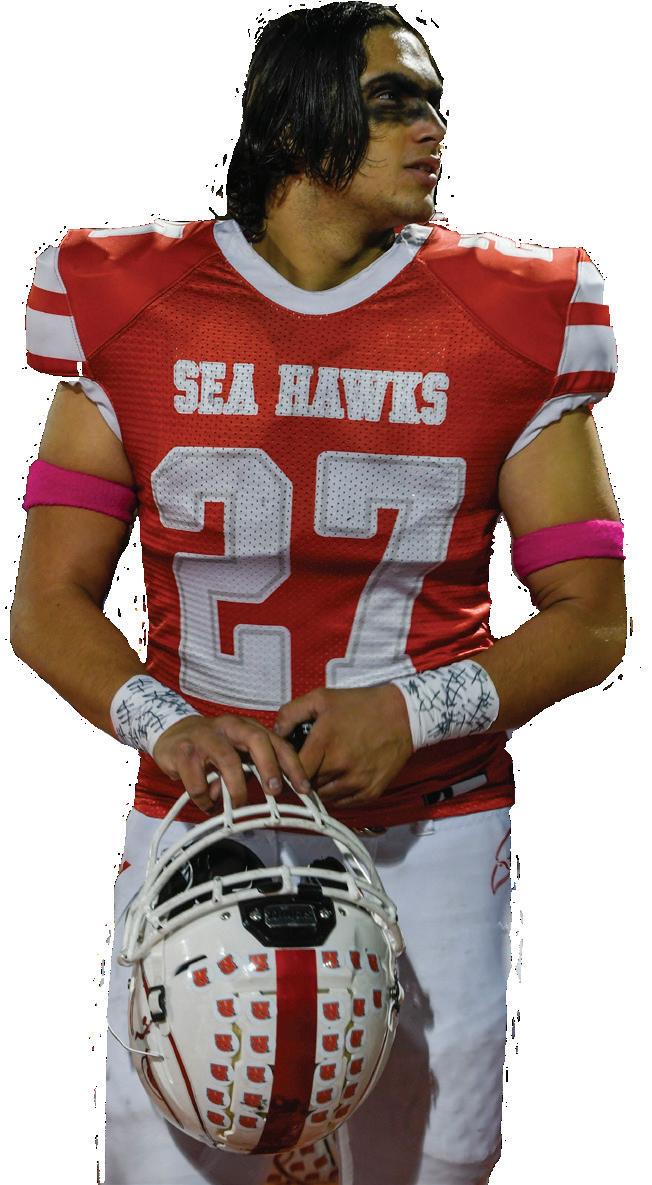
“We are playing Costa next week, and being able to compete with this high-level team [PV], a team that continues to exceed my expectations, gives us way more conf dence in our upcoming games within and outside of CIF,” Guenther said.
by Andrew McKennaOn Friday, Oct. 14, a 6-1 Redondo Union football team returned to the Sea Hawk Bowl to play in front of a home crowd for the frst time in nearly a month. Fresh of their frst loss of the season to Culver City, Redondo was looking to get back on track against fellow Bay League member Palos Verdes High School (PV). PV had won three straight games heading into the night, outscoring
their opponents 137-10 during that span. As Redondo would soon discover, PV’s re cent success was not a fuke.
Right of the bat, PV marched down the feld undeterred, picking Redondo’s de fense apart before they eventually scored on a six-yard touchdown pass. A poor sit uation turned worse when Redondo was fagged for jumping ofsides on the PAT (lining up to attempt a one-point feld goal), leading PV to attempt a two-point try, which they successfully converted. Simple mistakes such as this appeared to be a common theme for Redondo, and PV took advantage.
“We just beat ourselves with men tal mistakes and mental errors,” senior strong-safety Caden Telleson said. “We can beat that team if we play better defense and make a couple more plays on ofense. It was just the small details this week. We need to keep working in practice and get better.”
After forcing a quick punt on PV’s sec ond drive, Redondo’s defense appeared to be getting back on track. On a third and short within PV’s own 20-yard line with momentum starting to shift towards Redondo, PV senior quarterback Charlie Beuerlein dropped back and lofted a pass to the far sideline, where it was caught for a 25-yard gain. Just a few plays later, the drive ended with an 18-yard passing touch down, leaving Redondo with a soul-crush ing 28 point defcit going into the second half.
“It was just bad communication on that play,” Telleson said. “The safeties, partially
me and partially some of the other safeties, didn’t shift out in time and we didn’t get to our man. We miscommunicated, we didn’t talk enough about it before the play and we just didn’t execute. It’s something we’ve practiced many times, we just have to ex ecute it now.”
Unfortunately for Redondo, the ofense did nothing to pick up the defense. On the frst play from scrimmage following the most recent PV touchdown, senior quarter back Christian Hunt targeted junior wide receiver Nate Stiveson on a short-passing play. Tracking Hunt’s eyes, a PV defen sive back jumped the route and ran the throw back for a pick-six. The frst play of the following drive was no better, as the snap soared over Hunt’s head before it was eventually recovered by the PV defense. PV would go on to score three plays later on a three-yard rushing touchdown.
“We didn’t do anything to help ourselves tonight,” Redondo head coach Keith Elli son said. “A lot of mistakes on our throws, a lot of miscommunications, misalignments and misplacements; our guys just weren’t in the right spots. I take a lot of the blame for that as the coach for not preparing us for it.”
Redondo would go to the locker room in a 28-point hole. According to Coach El lison, the only way to get back in a game that lopsided is to start fast and make more aggressive plays. After successfully driving down the feld all the way into the redzone, Redondo was now faced with a fourth and short. The ofense seemed to be clicking for the frst time all night, so Ellison decided
to roll the dice and go for it. That decision didn’t pan out.
“We were trying to fnd something to get some momentum going,” Ellison said. “I felt that if we could have come down and scored that drive, then we could have made a stop and gotten back into the game, but mistakes killed us again.”
Redondo’s ofense was given a gift a few plays later when the defense recovered a PV fumble, leaving them with great feld position, but they again failed to capital ize on the opportunity. The next play saw a ball get tipped at the line of scrimmage before eventually falling into the arms of a PV defender.
“I don’t think that it was all one posi tion’s fault; I just think that the ofense was just a little bit of tonight,” Telleson said. “I think that if we correct the small mistakes [we’ll be fne].
Redondo had one more nice drive be fore the game’s conclusion, but it ended scoreless. The game would end 35-0, leav ing Redondo without points for a second consecutive game. Looking past the score board, Telleson found a few positive points to build on for upcoming games.
“There’s just no quit in the defense. It doesn’t matter if it is 50-0; that’s not going to stop us,” Telleson said. “The same thing goes for the ofense. They keep trying to move the ball, Christian (Hunt) still hangs in the pocket, running backs are taking big hits and everyone is trying to make a play. At the end of the day, everyone is giving it their all, it’s just mental mistakes that are holding us back.”
Everyday, students are faced with new challenges and re sponsibilities. Whether it be a club, an AP class or an after-school sports activity, the pressure of flling one’s resume to the brim can break even the most well-organized and diligent students.
Key Club President and theater crew member senior Maya Patel spends the “vast majority” of her week either plan ning a new event for Key Club, working on homework for one of her many AP classes or designing sets for school mu sicals.
“Mentally, I would say that sleep deprivation and I are really good friends. We have become well acquaint ed throughout my last four years,” Patel said.
Sleep deprivation, an issue connected to the overabundance of responsibilities, is a condition that students, like Patel, have to balance. Patel also addresses the conficts associated with communication needed for when students fall behind in work.
“If the school could be a smidge more understanding about certain pressures put onto students that would be appre ciated,” Patel said. “It would be nice if
sponsibilities holds “more value” to her than pursuing perfection in everything she does.
“Theater and Key Club help me feel grounded in the fact that I'm a human being and I'm just doing what I love,” Patel said.
Similarly to Pa tel, ASB President and senior Reece Cartee, has “quite a bit of pressure” put onto her, due to her day-to-day respon sibilities.
sponsibilities”, such as her three AP classes, she still does “everything within her power” to act as a bridge between the general student body and ASB.
community. Clubs defnitely help, but the workload is still socially limiting,” Daley said.
Finding a balance with her respon sibilities allows for Daley to feel accept ed into a “great social community.” This feeling of acceptance led to her being less focused on perfectionism and more focused on understanding herself.
“I am trying my hardest to be pres ident, and I don’t know how hard or easy it appears to others, but it is a hard job,” Cartee said. “I take on a lot, but I still want to be here for the students if they need something or if they want change. I
PATEL SENIOR“I am taking the weight of the proj ects and upcoming events that we have. So, it afects my anxiety, and I get stressed out about trying to manage ev erything, but luckily I am able to let my teacher’s know that I’m a busy girl. I’m able to clearly commu nicate with my friends, fami ly, and teachers to make sure I’m getting every thing
done on time,” Cartee said.
Senior Catherine Tran, Red Cross Club president, echoes Cartee’s sentiments on the importance of com munity and how it can help to de-stress an environment.
One of the biggest causes of stress is a lack of balance. A lot of people have anxiety or high stress levels and they don't realize that they're doing too much until they're in a full blown crisis."
“Balancing everything with school is probably the hardest part because [fve AP classes] are demanding. Clubs involve a lot of commitment. In salsa I have to practice with my partner a lot outside of school, so practicing takes up a good chunk of time, even on weekends. And organizing for our next Asian Cul tures Club meetings definite ly takes a lot of time, and it can be stressful especially with all of my other responsibil ities,” Daley said.
“Mentally, I would say that I'm a lot more tired at the end of the day than I used to be, because [in addition to] stressing about school, I now have to think about [Red Cross] every day,” Tran said.
On top of mental struggles, junior Serena Daley speaks to the social strug gles tied to it. She is president of the Asian Cultures Club, a player on the girls basketball team and a member of Salsa Club, Model United Nations, Students against Destructive Decisions and Na tional American Mental Health Alliance. On top of that, she is vice president of the Red Cross Club. Holding these posi tions, Daley expereinces “both ups and downs” of these activities with regards to her social life.
“[I spend] most of my free time work ing [on homework]. But being involved in clubs is defnitely how I get my social life back. When I'm in my clubs, I get to talk to new people. I can be with my friends, and salsa especially is a great
Agreeing with Da ley’s opin ion on the importance of balance, school Men tal Health and Well ness coun selor Rachel Andrews often deals with overly stressed students who struggle to maintain a proper balance between their schoolwork and activities.

“One of the biggest causes of stress is lack of balance. A lot of people have anx iety or high stress levels and they don’t realize that they’re doing too much until they’re in a full blown crisis,” Andrews said.
The ability to healthily balance a va riety of responsibilities can be “largely based on what type of person” you are and how you “view school.”
“School plays a role in things getting out of balance especially if you’re one of those people who wants to be a part of everything, and so you’re signing up for everything and giving yourself to every club, every class, every sport until there's nothing left for yourself,” Andrews said.
Overworking has the potential to disturb student’s social life and mental state, but participating in a variety of activities and living for passions is one thing that Patel, Cartee, Tran and Daley all found in common.
“If you’re interested in trying some thing [new], it’s never too late, just go and see what happens,” Andrews said. “Take that risk, because that is how you will grow and fnd what you are looking for in life.”